IPv6 Network Implementation and Design
VerifiedAdded on 2020/03/23
|44
|7377
|65
AI Summary
This assignment details a project focused on implementing an IPv6 network using Cisco Packet Tracer. Students analyze network components, design the network layout, configure devices with appropriate protocols, and test connectivity. The project emphasizes adding hosts with IPv6 addresses without altering the existing network structure or cabling plan. Students also create a PowerPoint presentation to demonstrate their work.
Contribute Materials
Your contribution can guide someone’s learning journey. Share your
documents today.
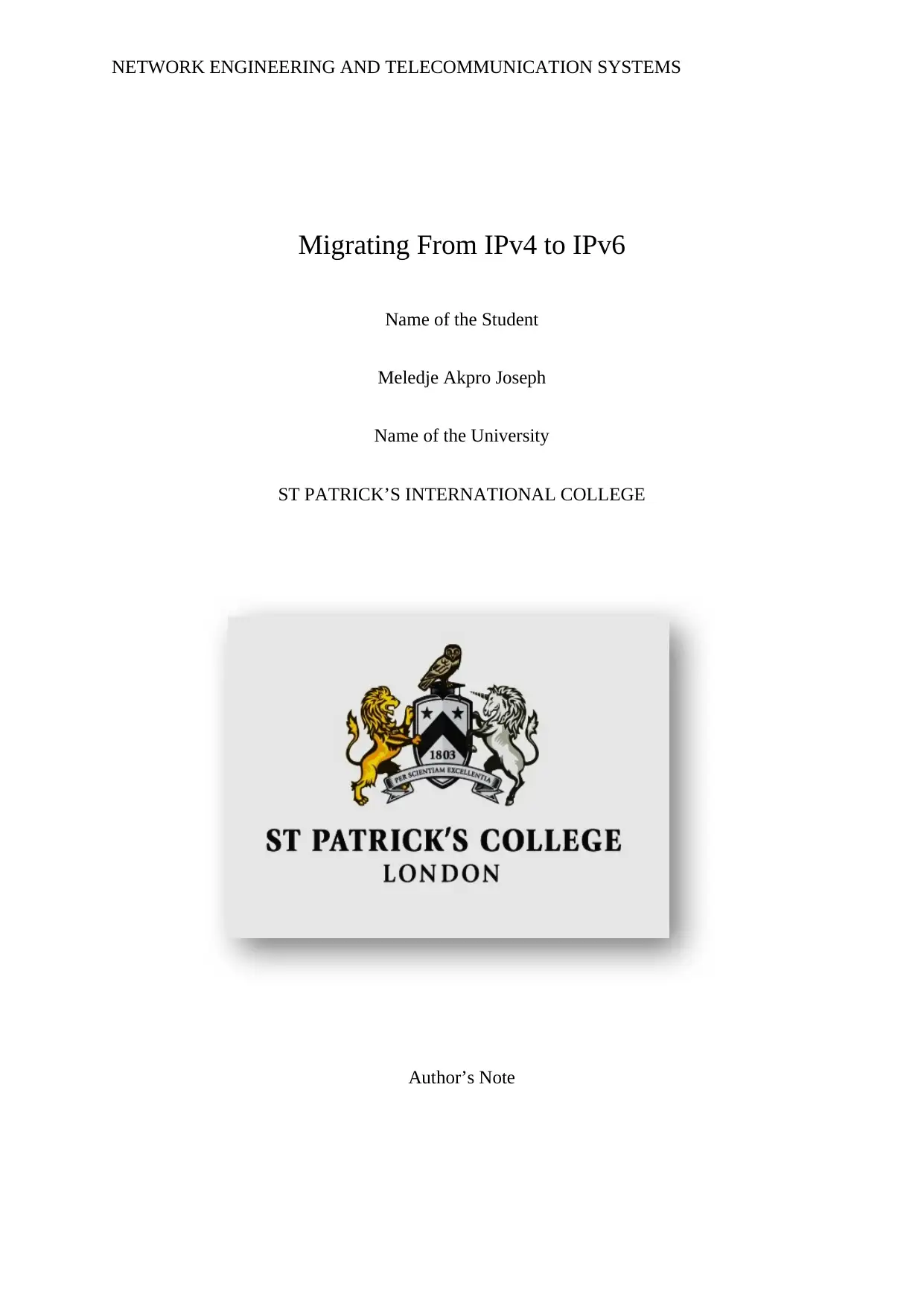
NETWORK ENGINEERING AND TELECOMMUNICATION SYSTEMS
Migrating From IPv4 to IPv6
Name of the Student
Meledje Akpro Joseph
Name of the University
ST PATRICK’S INTERNATIONAL COLLEGE
Author’s Note
Migrating From IPv4 to IPv6
Name of the Student
Meledje Akpro Joseph
Name of the University
ST PATRICK’S INTERNATIONAL COLLEGE
Author’s Note
Secure Best Marks with AI Grader
Need help grading? Try our AI Grader for instant feedback on your assignments.

1
NETWORK ENGINEERING AND TELECOMMUNICATION SYSTEMS
Acknowledgement
I predominantly obliged to express my gratitude and acknowledge to ST Patrick’s
International College, and our tutors for providing us valuable resources that helped us to
gain more knowledge in network engineering course. This project helped us to research on
the new available technology and protocol that helped us to gain practical knowledge. The
access of the college library helped us to solve the problem that we faced during the
development of the project.
I am thankful to our project supervisor Kamran Ali, and want to thank them heartily for
guiding us at every stage of development and helping us providing valuable resources and
inspiration for the final term.
I would also like to thank the principal of our college and for providing us the opportunity to
continue with the project and encourage us for the last two years of, ‘Person’s HND
Diploma’.
By Meledje Akpro Joseph
College Name: ST Patrick’s International College
Year 2
NETWORK ENGINEERING AND TELECOMMUNICATION SYSTEMS
Acknowledgement
I predominantly obliged to express my gratitude and acknowledge to ST Patrick’s
International College, and our tutors for providing us valuable resources that helped us to
gain more knowledge in network engineering course. This project helped us to research on
the new available technology and protocol that helped us to gain practical knowledge. The
access of the college library helped us to solve the problem that we faced during the
development of the project.
I am thankful to our project supervisor Kamran Ali, and want to thank them heartily for
guiding us at every stage of development and helping us providing valuable resources and
inspiration for the final term.
I would also like to thank the principal of our college and for providing us the opportunity to
continue with the project and encourage us for the last two years of, ‘Person’s HND
Diploma’.
By Meledje Akpro Joseph
College Name: ST Patrick’s International College
Year 2

2
NETWORK ENGINEERING AND TELECOMMUNICATION SYSTEMS
Table of Contents
CHAPTER 1 – INTRODUCTION............................................................................................6
1.1. Chapter Introduction.......................................................................................................6
1.2. Migrating from Ipv4 to Ipv6...........................................................................................6
1.3. Project Inspiration...........................................................................................................7
1.4. Problem Identification.....................................................................................................7
1.5. Solution...........................................................................................................................7
1.6. Aims................................................................................................................................8
1.7. Objectives........................................................................................................................8
1.8. Record risks, constraints and assumptions......................................................................8
1.9. Project plan and deliverables..........................................................................................9
1.10. Layout of the report.......................................................................................................9
1.11. Summary.....................................................................................................................10
CHAPTER 2 – LITERATURE REVIEW...............................................................................11
2.1. Chapter Introduction.....................................................................................................11
2.2. Literature review based on domain...............................................................................11
2.2.1. Understanding the IPv6 concept............................................................................11
2.3. Reasons for the Project..................................................................................................12
2.4. Business Options...........................................................................................................12
2.5. Current System..............................................................................................................13
2.6. Problems found in the system.......................................................................................14
NETWORK ENGINEERING AND TELECOMMUNICATION SYSTEMS
Table of Contents
CHAPTER 1 – INTRODUCTION............................................................................................6
1.1. Chapter Introduction.......................................................................................................6
1.2. Migrating from Ipv4 to Ipv6...........................................................................................6
1.3. Project Inspiration...........................................................................................................7
1.4. Problem Identification.....................................................................................................7
1.5. Solution...........................................................................................................................7
1.6. Aims................................................................................................................................8
1.7. Objectives........................................................................................................................8
1.8. Record risks, constraints and assumptions......................................................................8
1.9. Project plan and deliverables..........................................................................................9
1.10. Layout of the report.......................................................................................................9
1.11. Summary.....................................................................................................................10
CHAPTER 2 – LITERATURE REVIEW...............................................................................11
2.1. Chapter Introduction.....................................................................................................11
2.2. Literature review based on domain...............................................................................11
2.2.1. Understanding the IPv6 concept............................................................................11
2.3. Reasons for the Project..................................................................................................12
2.4. Business Options...........................................................................................................12
2.5. Current System..............................................................................................................13
2.6. Problems found in the system.......................................................................................14

3
NETWORK ENGINEERING AND TELECOMMUNICATION SYSTEMS
2.7. Hardware components required for the development of the project.............................14
2.8. Technology analyzed....................................................................................................15
2.8.1. Tunneling...............................................................................................................15
2.8.2. IPv6 address with embedded Ipv4 address............................................................15
2.9. Drawback of the proposed solution...............................................................................15
2.9.1. Solution..................................................................................................................16
2.10. Benefits of the project.................................................................................................16
2.11. Development tools and techniques..............................................................................16
2.11.1. Designing software...............................................................................................17
2.11.2. Simulation Software.............................................................................................18
2.11.3. Summary..............................................................................................................18
CHAPTER 3 – ANALYSIS AND DESIGN...........................................................................18
3.1. Discussion of the analysis.............................................................................................18
3.2. Discussion of the design................................................................................................19
3.3. Development Methodology...........................................................................................19
CHAPTER 4 – IMPLEMENTATION.....................................................................................20
4.1. Introduction...................................................................................................................20
4.2. Implementation of the proposed solution......................................................................20
4.2.1. Challenges faced during the implementation.........................................................21
4.3. Demonstration of the Artifacts......................................................................................21
4.3.1. Configuration of the device....................................................................................21
NETWORK ENGINEERING AND TELECOMMUNICATION SYSTEMS
2.7. Hardware components required for the development of the project.............................14
2.8. Technology analyzed....................................................................................................15
2.8.1. Tunneling...............................................................................................................15
2.8.2. IPv6 address with embedded Ipv4 address............................................................15
2.9. Drawback of the proposed solution...............................................................................15
2.9.1. Solution..................................................................................................................16
2.10. Benefits of the project.................................................................................................16
2.11. Development tools and techniques..............................................................................16
2.11.1. Designing software...............................................................................................17
2.11.2. Simulation Software.............................................................................................18
2.11.3. Summary..............................................................................................................18
CHAPTER 3 – ANALYSIS AND DESIGN...........................................................................18
3.1. Discussion of the analysis.............................................................................................18
3.2. Discussion of the design................................................................................................19
3.3. Development Methodology...........................................................................................19
CHAPTER 4 – IMPLEMENTATION.....................................................................................20
4.1. Introduction...................................................................................................................20
4.2. Implementation of the proposed solution......................................................................20
4.2.1. Challenges faced during the implementation.........................................................21
4.3. Demonstration of the Artifacts......................................................................................21
4.3.1. Configuration of the device....................................................................................21
Secure Best Marks with AI Grader
Need help grading? Try our AI Grader for instant feedback on your assignments.

4
NETWORK ENGINEERING AND TELECOMMUNICATION SYSTEMS
4.3.2. Auto Configuration of Ipv6 address.......................................................................26
4.4. Summary.......................................................................................................................28
CHAPTER 5 – TESTING........................................................................................................28
5.1. Testing techniques.........................................................................................................28
5.2. Testing plan...................................................................................................................28
5.2.1. Show run Configuration.........................................................................................29
5.3. Discussion.....................................................................................................................30
CHAPTER 6 – EVALUATION AND CONCLUSION..........................................................32
OVERALL CONCLUSION SUMMARY...............................................................................32
Future development..................................................................................................................33
References................................................................................................................................34
Appendix - A............................................................................................................................36
HND PROJECT PRESENTATION....................................................................................36
Appendix – B...........................................................................................................................39
PROJECT SPECIFICATION DOCUMENT.......................................................................39
NETWORK ENGINEERING AND TELECOMMUNICATION SYSTEMS
4.3.2. Auto Configuration of Ipv6 address.......................................................................26
4.4. Summary.......................................................................................................................28
CHAPTER 5 – TESTING........................................................................................................28
5.1. Testing techniques.........................................................................................................28
5.2. Testing plan...................................................................................................................28
5.2.1. Show run Configuration.........................................................................................29
5.3. Discussion.....................................................................................................................30
CHAPTER 6 – EVALUATION AND CONCLUSION..........................................................32
OVERALL CONCLUSION SUMMARY...............................................................................32
Future development..................................................................................................................33
References................................................................................................................................34
Appendix - A............................................................................................................................36
HND PROJECT PRESENTATION....................................................................................36
Appendix – B...........................................................................................................................39
PROJECT SPECIFICATION DOCUMENT.......................................................................39

5
NETWORK ENGINEERING AND TELECOMMUNICATION SYSTEMS
List of Figures
Figure 1: Gantt chart prepared for the project planning.............................................................9
NETWORK ENGINEERING AND TELECOMMUNICATION SYSTEMS
List of Figures
Figure 1: Gantt chart prepared for the project planning.............................................................9
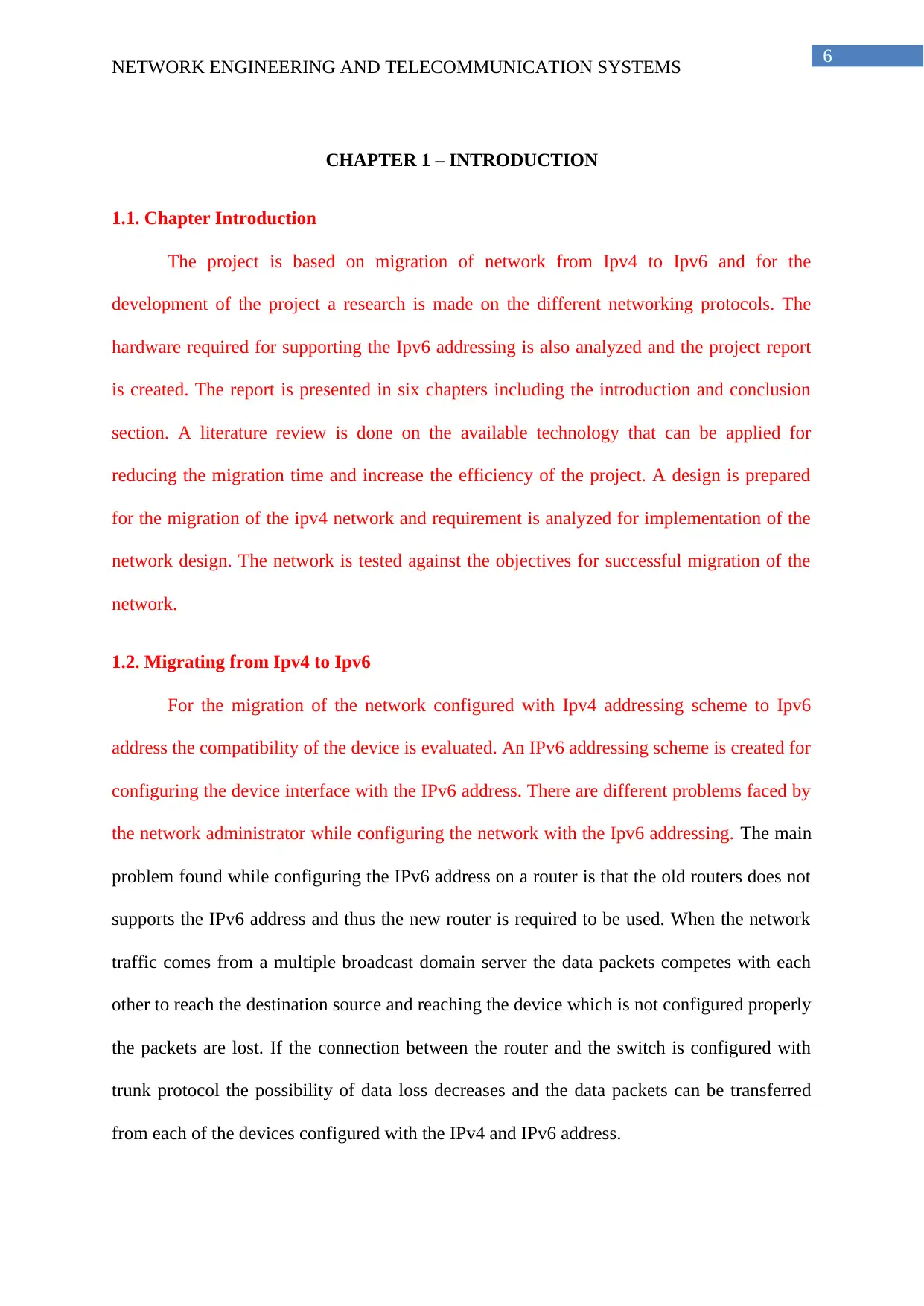
6
NETWORK ENGINEERING AND TELECOMMUNICATION SYSTEMS
CHAPTER 1 – INTRODUCTION
1.1. Chapter Introduction
The project is based on migration of network from Ipv4 to Ipv6 and for the
development of the project a research is made on the different networking protocols. The
hardware required for supporting the Ipv6 addressing is also analyzed and the project report
is created. The report is presented in six chapters including the introduction and conclusion
section. A literature review is done on the available technology that can be applied for
reducing the migration time and increase the efficiency of the project. A design is prepared
for the migration of the ipv4 network and requirement is analyzed for implementation of the
network design. The network is tested against the objectives for successful migration of the
network.
1.2. Migrating from Ipv4 to Ipv6
For the migration of the network configured with Ipv4 addressing scheme to Ipv6
address the compatibility of the device is evaluated. An IPv6 addressing scheme is created for
configuring the device interface with the IPv6 address. There are different problems faced by
the network administrator while configuring the network with the Ipv6 addressing. The main
problem found while configuring the IPv6 address on a router is that the old routers does not
supports the IPv6 address and thus the new router is required to be used. When the network
traffic comes from a multiple broadcast domain server the data packets competes with each
other to reach the destination source and reaching the device which is not configured properly
the packets are lost. If the connection between the router and the switch is configured with
trunk protocol the possibility of data loss decreases and the data packets can be transferred
from each of the devices configured with the IPv4 and IPv6 address.
NETWORK ENGINEERING AND TELECOMMUNICATION SYSTEMS
CHAPTER 1 – INTRODUCTION
1.1. Chapter Introduction
The project is based on migration of network from Ipv4 to Ipv6 and for the
development of the project a research is made on the different networking protocols. The
hardware required for supporting the Ipv6 addressing is also analyzed and the project report
is created. The report is presented in six chapters including the introduction and conclusion
section. A literature review is done on the available technology that can be applied for
reducing the migration time and increase the efficiency of the project. A design is prepared
for the migration of the ipv4 network and requirement is analyzed for implementation of the
network design. The network is tested against the objectives for successful migration of the
network.
1.2. Migrating from Ipv4 to Ipv6
For the migration of the network configured with Ipv4 addressing scheme to Ipv6
address the compatibility of the device is evaluated. An IPv6 addressing scheme is created for
configuring the device interface with the IPv6 address. There are different problems faced by
the network administrator while configuring the network with the Ipv6 addressing. The main
problem found while configuring the IPv6 address on a router is that the old routers does not
supports the IPv6 address and thus the new router is required to be used. When the network
traffic comes from a multiple broadcast domain server the data packets competes with each
other to reach the destination source and reaching the device which is not configured properly
the packets are lost. If the connection between the router and the switch is configured with
trunk protocol the possibility of data loss decreases and the data packets can be transferred
from each of the devices configured with the IPv4 and IPv6 address.
Paraphrase This Document
Need a fresh take? Get an instant paraphrase of this document with our AI Paraphraser
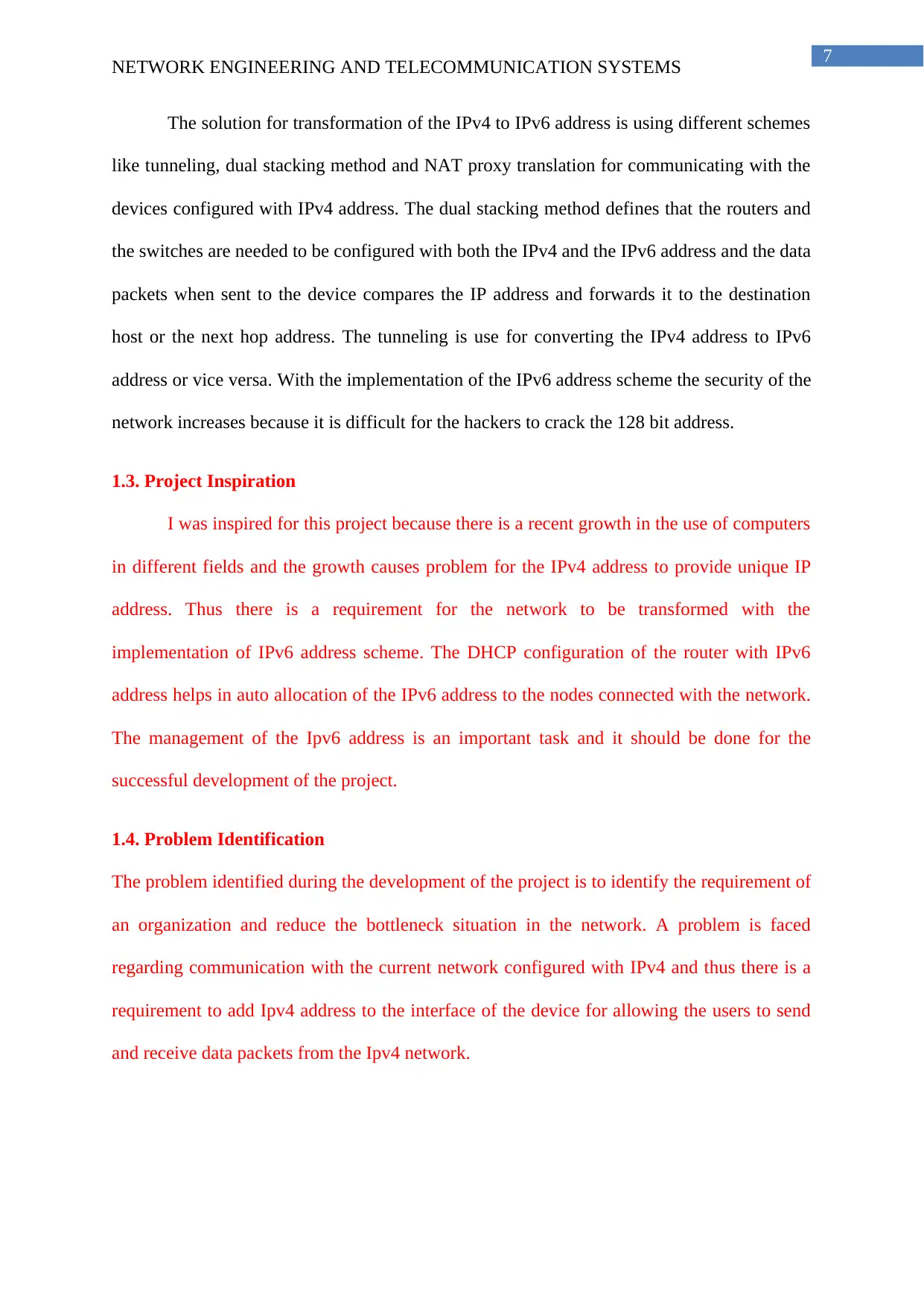
7
NETWORK ENGINEERING AND TELECOMMUNICATION SYSTEMS
The solution for transformation of the IPv4 to IPv6 address is using different schemes
like tunneling, dual stacking method and NAT proxy translation for communicating with the
devices configured with IPv4 address. The dual stacking method defines that the routers and
the switches are needed to be configured with both the IPv4 and the IPv6 address and the data
packets when sent to the device compares the IP address and forwards it to the destination
host or the next hop address. The tunneling is use for converting the IPv4 address to IPv6
address or vice versa. With the implementation of the IPv6 address scheme the security of the
network increases because it is difficult for the hackers to crack the 128 bit address.
1.3. Project Inspiration
I was inspired for this project because there is a recent growth in the use of computers
in different fields and the growth causes problem for the IPv4 address to provide unique IP
address. Thus there is a requirement for the network to be transformed with the
implementation of IPv6 address scheme. The DHCP configuration of the router with IPv6
address helps in auto allocation of the IPv6 address to the nodes connected with the network.
The management of the Ipv6 address is an important task and it should be done for the
successful development of the project.
1.4. Problem Identification
The problem identified during the development of the project is to identify the requirement of
an organization and reduce the bottleneck situation in the network. A problem is faced
regarding communication with the current network configured with IPv4 and thus there is a
requirement to add Ipv4 address to the interface of the device for allowing the users to send
and receive data packets from the Ipv4 network.
NETWORK ENGINEERING AND TELECOMMUNICATION SYSTEMS
The solution for transformation of the IPv4 to IPv6 address is using different schemes
like tunneling, dual stacking method and NAT proxy translation for communicating with the
devices configured with IPv4 address. The dual stacking method defines that the routers and
the switches are needed to be configured with both the IPv4 and the IPv6 address and the data
packets when sent to the device compares the IP address and forwards it to the destination
host or the next hop address. The tunneling is use for converting the IPv4 address to IPv6
address or vice versa. With the implementation of the IPv6 address scheme the security of the
network increases because it is difficult for the hackers to crack the 128 bit address.
1.3. Project Inspiration
I was inspired for this project because there is a recent growth in the use of computers
in different fields and the growth causes problem for the IPv4 address to provide unique IP
address. Thus there is a requirement for the network to be transformed with the
implementation of IPv6 address scheme. The DHCP configuration of the router with IPv6
address helps in auto allocation of the IPv6 address to the nodes connected with the network.
The management of the Ipv6 address is an important task and it should be done for the
successful development of the project.
1.4. Problem Identification
The problem identified during the development of the project is to identify the requirement of
an organization and reduce the bottleneck situation in the network. A problem is faced
regarding communication with the current network configured with IPv4 and thus there is a
requirement to add Ipv4 address to the interface of the device for allowing the users to send
and receive data packets from the Ipv4 network.
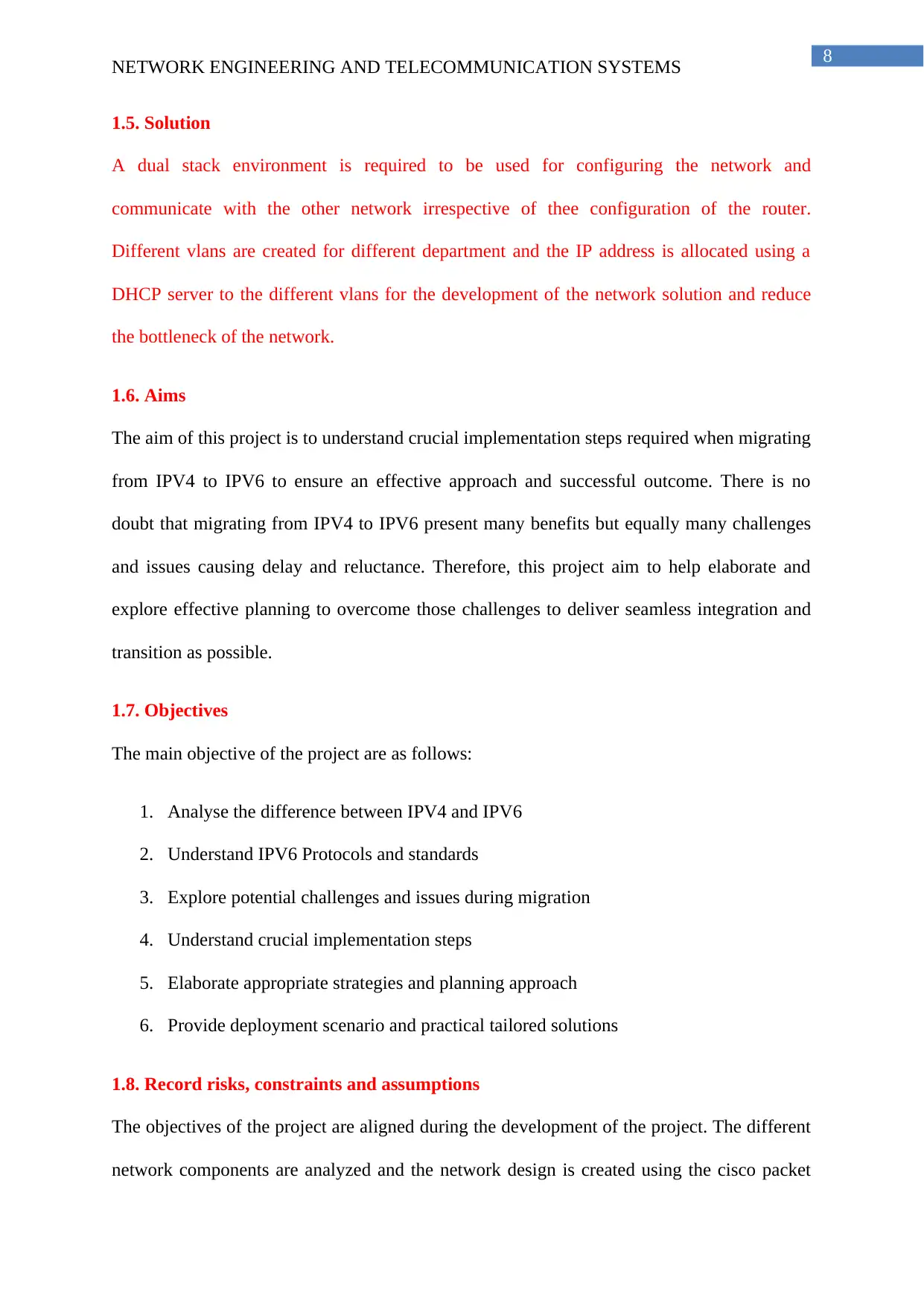
8
NETWORK ENGINEERING AND TELECOMMUNICATION SYSTEMS
1.5. Solution
A dual stack environment is required to be used for configuring the network and
communicate with the other network irrespective of thee configuration of the router.
Different vlans are created for different department and the IP address is allocated using a
DHCP server to the different vlans for the development of the network solution and reduce
the bottleneck of the network.
1.6. Aims
The aim of this project is to understand crucial implementation steps required when migrating
from IPV4 to IPV6 to ensure an effective approach and successful outcome. There is no
doubt that migrating from IPV4 to IPV6 present many benefits but equally many challenges
and issues causing delay and reluctance. Therefore, this project aim to help elaborate and
explore effective planning to overcome those challenges to deliver seamless integration and
transition as possible.
1.7. Objectives
The main objective of the project are as follows:
1. Analyse the difference between IPV4 and IPV6
2. Understand IPV6 Protocols and standards
3. Explore potential challenges and issues during migration
4. Understand crucial implementation steps
5. Elaborate appropriate strategies and planning approach
6. Provide deployment scenario and practical tailored solutions
1.8. Record risks, constraints and assumptions
The objectives of the project are aligned during the development of the project. The different
network components are analyzed and the network design is created using the cisco packet
NETWORK ENGINEERING AND TELECOMMUNICATION SYSTEMS
1.5. Solution
A dual stack environment is required to be used for configuring the network and
communicate with the other network irrespective of thee configuration of the router.
Different vlans are created for different department and the IP address is allocated using a
DHCP server to the different vlans for the development of the network solution and reduce
the bottleneck of the network.
1.6. Aims
The aim of this project is to understand crucial implementation steps required when migrating
from IPV4 to IPV6 to ensure an effective approach and successful outcome. There is no
doubt that migrating from IPV4 to IPV6 present many benefits but equally many challenges
and issues causing delay and reluctance. Therefore, this project aim to help elaborate and
explore effective planning to overcome those challenges to deliver seamless integration and
transition as possible.
1.7. Objectives
The main objective of the project are as follows:
1. Analyse the difference between IPV4 and IPV6
2. Understand IPV6 Protocols and standards
3. Explore potential challenges and issues during migration
4. Understand crucial implementation steps
5. Elaborate appropriate strategies and planning approach
6. Provide deployment scenario and practical tailored solutions
1.8. Record risks, constraints and assumptions
The objectives of the project are aligned during the development of the project. The different
network components are analyzed and the network design is created using the cisco packet
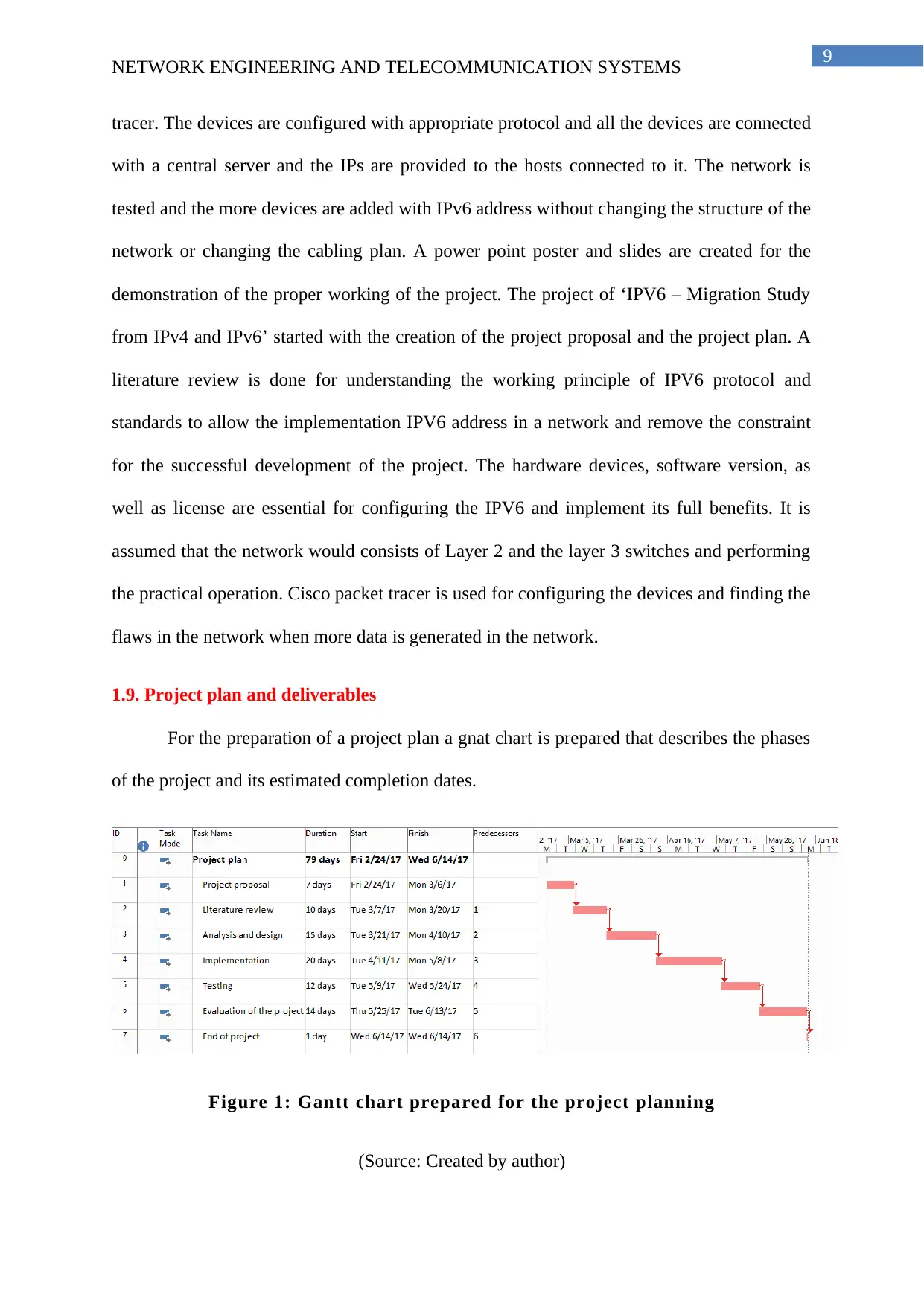
9
NETWORK ENGINEERING AND TELECOMMUNICATION SYSTEMS
tracer. The devices are configured with appropriate protocol and all the devices are connected
with a central server and the IPs are provided to the hosts connected to it. The network is
tested and the more devices are added with IPv6 address without changing the structure of the
network or changing the cabling plan. A power point poster and slides are created for the
demonstration of the proper working of the project. The project of ‘IPV6 – Migration Study
from IPv4 and IPv6’ started with the creation of the project proposal and the project plan. A
literature review is done for understanding the working principle of IPV6 protocol and
standards to allow the implementation IPV6 address in a network and remove the constraint
for the successful development of the project. The hardware devices, software version, as
well as license are essential for configuring the IPV6 and implement its full benefits. It is
assumed that the network would consists of Layer 2 and the layer 3 switches and performing
the practical operation. Cisco packet tracer is used for configuring the devices and finding the
flaws in the network when more data is generated in the network.
1.9. Project plan and deliverables
For the preparation of a project plan a gnat chart is prepared that describes the phases
of the project and its estimated completion dates.
Figure 1: Gantt chart prepared for the project planning
(Source: Created by author)
NETWORK ENGINEERING AND TELECOMMUNICATION SYSTEMS
tracer. The devices are configured with appropriate protocol and all the devices are connected
with a central server and the IPs are provided to the hosts connected to it. The network is
tested and the more devices are added with IPv6 address without changing the structure of the
network or changing the cabling plan. A power point poster and slides are created for the
demonstration of the proper working of the project. The project of ‘IPV6 – Migration Study
from IPv4 and IPv6’ started with the creation of the project proposal and the project plan. A
literature review is done for understanding the working principle of IPV6 protocol and
standards to allow the implementation IPV6 address in a network and remove the constraint
for the successful development of the project. The hardware devices, software version, as
well as license are essential for configuring the IPV6 and implement its full benefits. It is
assumed that the network would consists of Layer 2 and the layer 3 switches and performing
the practical operation. Cisco packet tracer is used for configuring the devices and finding the
flaws in the network when more data is generated in the network.
1.9. Project plan and deliverables
For the preparation of a project plan a gnat chart is prepared that describes the phases
of the project and its estimated completion dates.
Figure 1: Gantt chart prepared for the project planning
(Source: Created by author)
Secure Best Marks with AI Grader
Need help grading? Try our AI Grader for instant feedback on your assignments.

10
NETWORK ENGINEERING AND TELECOMMUNICATION SYSTEMS
1.10. Layout of the report
Chapter 1: The chapter 1 is the introduction and it defines the migration of the Ipv4 to Ipv6
addressing. The inspiration of the project is defined and the problem faced during the
development of the project is analyzed for the development of the project. The solution of the
project is given and the aims and the objectives of the project is defined for successful
development of the project. The risk associated with the development of the project s
identified and assumptions are made for the development of the project.
Chapter 2: The second chapter is the literature review of the assignment and different papers
based on Ipv6 are studied for the development of the project. The different protocols that are
used for the configuration of the router are analyzed. The aims and objectives of the report is
aligned with different case study and the concept is created for the development network
solution.
Chapter 3: the third chapter discusses about the different design that can be used for
designing the Ipv6 network and an analysis is made on the available technology that can be
applied for the development of the network solution. Main focus is given on the hardware
that can be used and the existing system is converged for the development of the Ipv6
framework.
Chapter 4: The chapter four is the implementation stage of the project and the network is
configured in cisco packet tracer and simulated for testing the connectivity between different
devices attached with the switch.
Chapter 5: The network is tested in the chapter and the result are attached in the report.
Chapter 6: The report is concluded and the result of the test is given in this chapter.
NETWORK ENGINEERING AND TELECOMMUNICATION SYSTEMS
1.10. Layout of the report
Chapter 1: The chapter 1 is the introduction and it defines the migration of the Ipv4 to Ipv6
addressing. The inspiration of the project is defined and the problem faced during the
development of the project is analyzed for the development of the project. The solution of the
project is given and the aims and the objectives of the project is defined for successful
development of the project. The risk associated with the development of the project s
identified and assumptions are made for the development of the project.
Chapter 2: The second chapter is the literature review of the assignment and different papers
based on Ipv6 are studied for the development of the project. The different protocols that are
used for the configuration of the router are analyzed. The aims and objectives of the report is
aligned with different case study and the concept is created for the development network
solution.
Chapter 3: the third chapter discusses about the different design that can be used for
designing the Ipv6 network and an analysis is made on the available technology that can be
applied for the development of the network solution. Main focus is given on the hardware
that can be used and the existing system is converged for the development of the Ipv6
framework.
Chapter 4: The chapter four is the implementation stage of the project and the network is
configured in cisco packet tracer and simulated for testing the connectivity between different
devices attached with the switch.
Chapter 5: The network is tested in the chapter and the result are attached in the report.
Chapter 6: The report is concluded and the result of the test is given in this chapter.
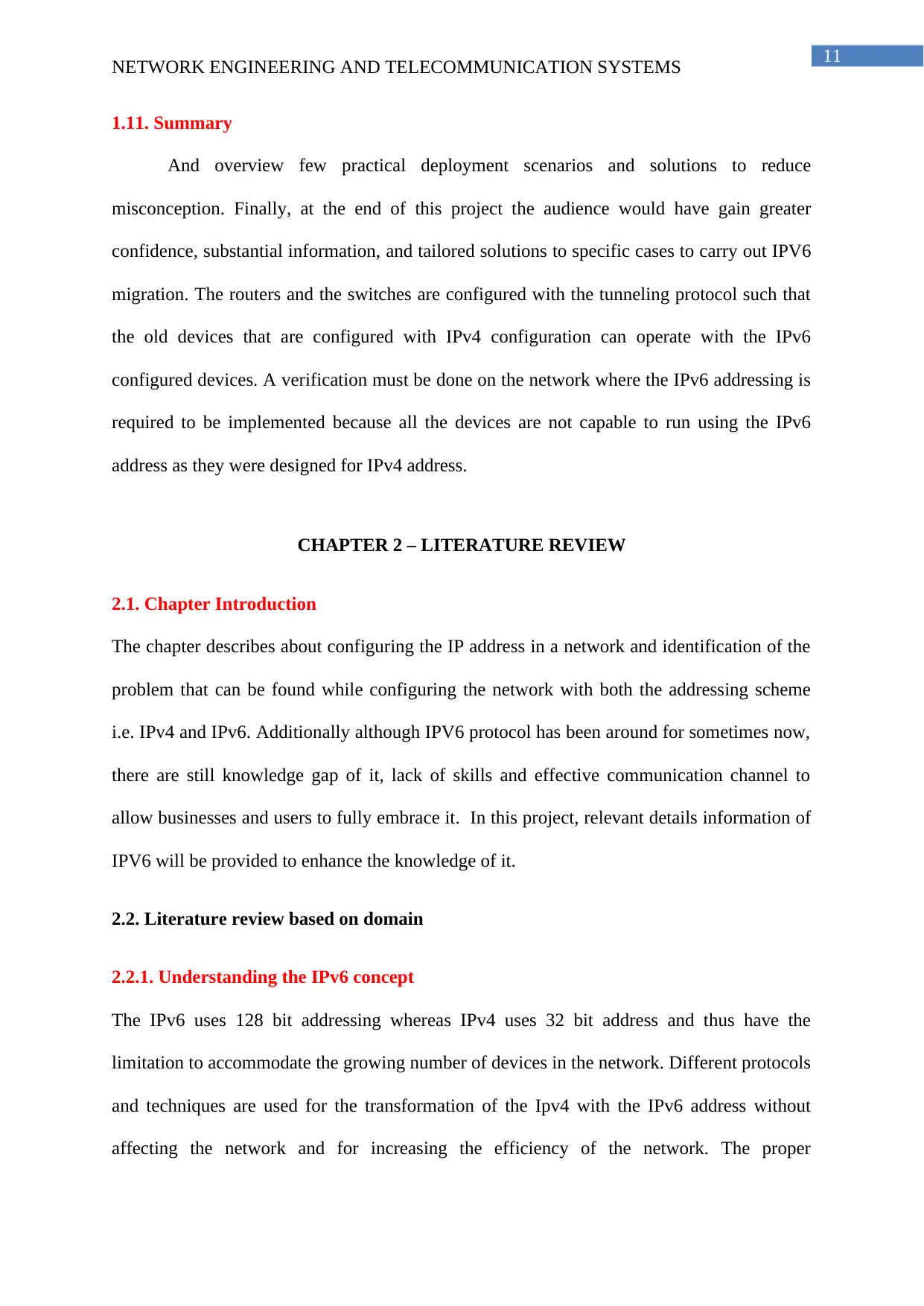
11
NETWORK ENGINEERING AND TELECOMMUNICATION SYSTEMS
1.11. Summary
And overview few practical deployment scenarios and solutions to reduce
misconception. Finally, at the end of this project the audience would have gain greater
confidence, substantial information, and tailored solutions to specific cases to carry out IPV6
migration. The routers and the switches are configured with the tunneling protocol such that
the old devices that are configured with IPv4 configuration can operate with the IPv6
configured devices. A verification must be done on the network where the IPv6 addressing is
required to be implemented because all the devices are not capable to run using the IPv6
address as they were designed for IPv4 address.
CHAPTER 2 – LITERATURE REVIEW
2.1. Chapter Introduction
The chapter describes about configuring the IP address in a network and identification of the
problem that can be found while configuring the network with both the addressing scheme
i.e. IPv4 and IPv6. Additionally although IPV6 protocol has been around for sometimes now,
there are still knowledge gap of it, lack of skills and effective communication channel to
allow businesses and users to fully embrace it. In this project, relevant details information of
IPV6 will be provided to enhance the knowledge of it.
2.2. Literature review based on domain
2.2.1. Understanding the IPv6 concept
The IPv6 uses 128 bit addressing whereas IPv4 uses 32 bit address and thus have the
limitation to accommodate the growing number of devices in the network. Different protocols
and techniques are used for the transformation of the Ipv4 with the IPv6 address without
affecting the network and for increasing the efficiency of the network. The proper
NETWORK ENGINEERING AND TELECOMMUNICATION SYSTEMS
1.11. Summary
And overview few practical deployment scenarios and solutions to reduce
misconception. Finally, at the end of this project the audience would have gain greater
confidence, substantial information, and tailored solutions to specific cases to carry out IPV6
migration. The routers and the switches are configured with the tunneling protocol such that
the old devices that are configured with IPv4 configuration can operate with the IPv6
configured devices. A verification must be done on the network where the IPv6 addressing is
required to be implemented because all the devices are not capable to run using the IPv6
address as they were designed for IPv4 address.
CHAPTER 2 – LITERATURE REVIEW
2.1. Chapter Introduction
The chapter describes about configuring the IP address in a network and identification of the
problem that can be found while configuring the network with both the addressing scheme
i.e. IPv4 and IPv6. Additionally although IPV6 protocol has been around for sometimes now,
there are still knowledge gap of it, lack of skills and effective communication channel to
allow businesses and users to fully embrace it. In this project, relevant details information of
IPV6 will be provided to enhance the knowledge of it.
2.2. Literature review based on domain
2.2.1. Understanding the IPv6 concept
The IPv6 uses 128 bit addressing whereas IPv4 uses 32 bit address and thus have the
limitation to accommodate the growing number of devices in the network. Different protocols
and techniques are used for the transformation of the Ipv4 with the IPv6 address without
affecting the network and for increasing the efficiency of the network. The proper
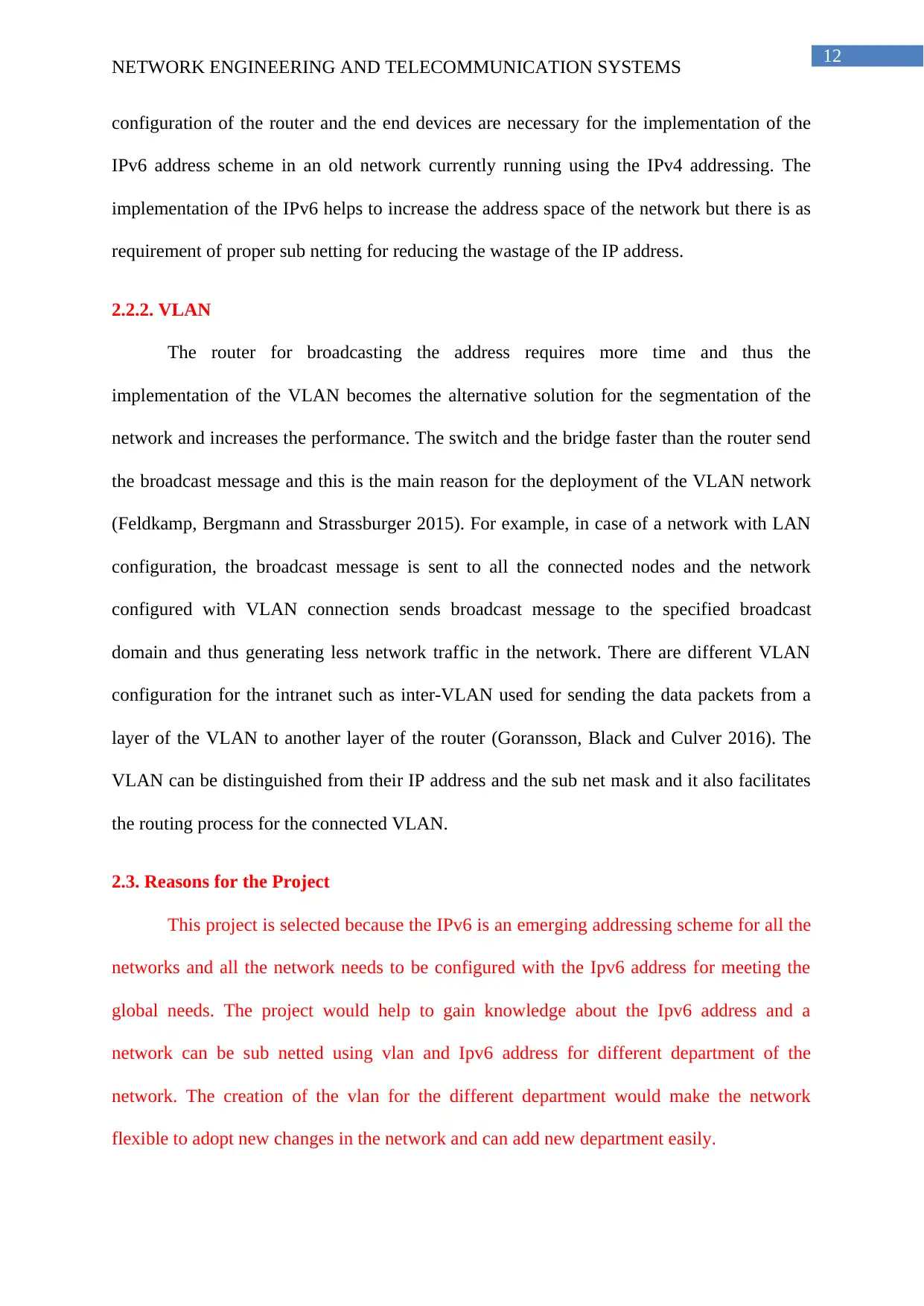
12
NETWORK ENGINEERING AND TELECOMMUNICATION SYSTEMS
configuration of the router and the end devices are necessary for the implementation of the
IPv6 address scheme in an old network currently running using the IPv4 addressing. The
implementation of the IPv6 helps to increase the address space of the network but there is as
requirement of proper sub netting for reducing the wastage of the IP address.
2.2.2. VLAN
The router for broadcasting the address requires more time and thus the
implementation of the VLAN becomes the alternative solution for the segmentation of the
network and increases the performance. The switch and the bridge faster than the router send
the broadcast message and this is the main reason for the deployment of the VLAN network
(Feldkamp, Bergmann and Strassburger 2015). For example, in case of a network with LAN
configuration, the broadcast message is sent to all the connected nodes and the network
configured with VLAN connection sends broadcast message to the specified broadcast
domain and thus generating less network traffic in the network. There are different VLAN
configuration for the intranet such as inter-VLAN used for sending the data packets from a
layer of the VLAN to another layer of the router (Goransson, Black and Culver 2016). The
VLAN can be distinguished from their IP address and the sub net mask and it also facilitates
the routing process for the connected VLAN.
2.3. Reasons for the Project
This project is selected because the IPv6 is an emerging addressing scheme for all the
networks and all the network needs to be configured with the Ipv6 address for meeting the
global needs. The project would help to gain knowledge about the Ipv6 address and a
network can be sub netted using vlan and Ipv6 address for different department of the
network. The creation of the vlan for the different department would make the network
flexible to adopt new changes in the network and can add new department easily.
NETWORK ENGINEERING AND TELECOMMUNICATION SYSTEMS
configuration of the router and the end devices are necessary for the implementation of the
IPv6 address scheme in an old network currently running using the IPv4 addressing. The
implementation of the IPv6 helps to increase the address space of the network but there is as
requirement of proper sub netting for reducing the wastage of the IP address.
2.2.2. VLAN
The router for broadcasting the address requires more time and thus the
implementation of the VLAN becomes the alternative solution for the segmentation of the
network and increases the performance. The switch and the bridge faster than the router send
the broadcast message and this is the main reason for the deployment of the VLAN network
(Feldkamp, Bergmann and Strassburger 2015). For example, in case of a network with LAN
configuration, the broadcast message is sent to all the connected nodes and the network
configured with VLAN connection sends broadcast message to the specified broadcast
domain and thus generating less network traffic in the network. There are different VLAN
configuration for the intranet such as inter-VLAN used for sending the data packets from a
layer of the VLAN to another layer of the router (Goransson, Black and Culver 2016). The
VLAN can be distinguished from their IP address and the sub net mask and it also facilitates
the routing process for the connected VLAN.
2.3. Reasons for the Project
This project is selected because the IPv6 is an emerging addressing scheme for all the
networks and all the network needs to be configured with the Ipv6 address for meeting the
global needs. The project would help to gain knowledge about the Ipv6 address and a
network can be sub netted using vlan and Ipv6 address for different department of the
network. The creation of the vlan for the different department would make the network
flexible to adopt new changes in the network and can add new department easily.
Paraphrase This Document
Need a fresh take? Get an instant paraphrase of this document with our AI Paraphraser
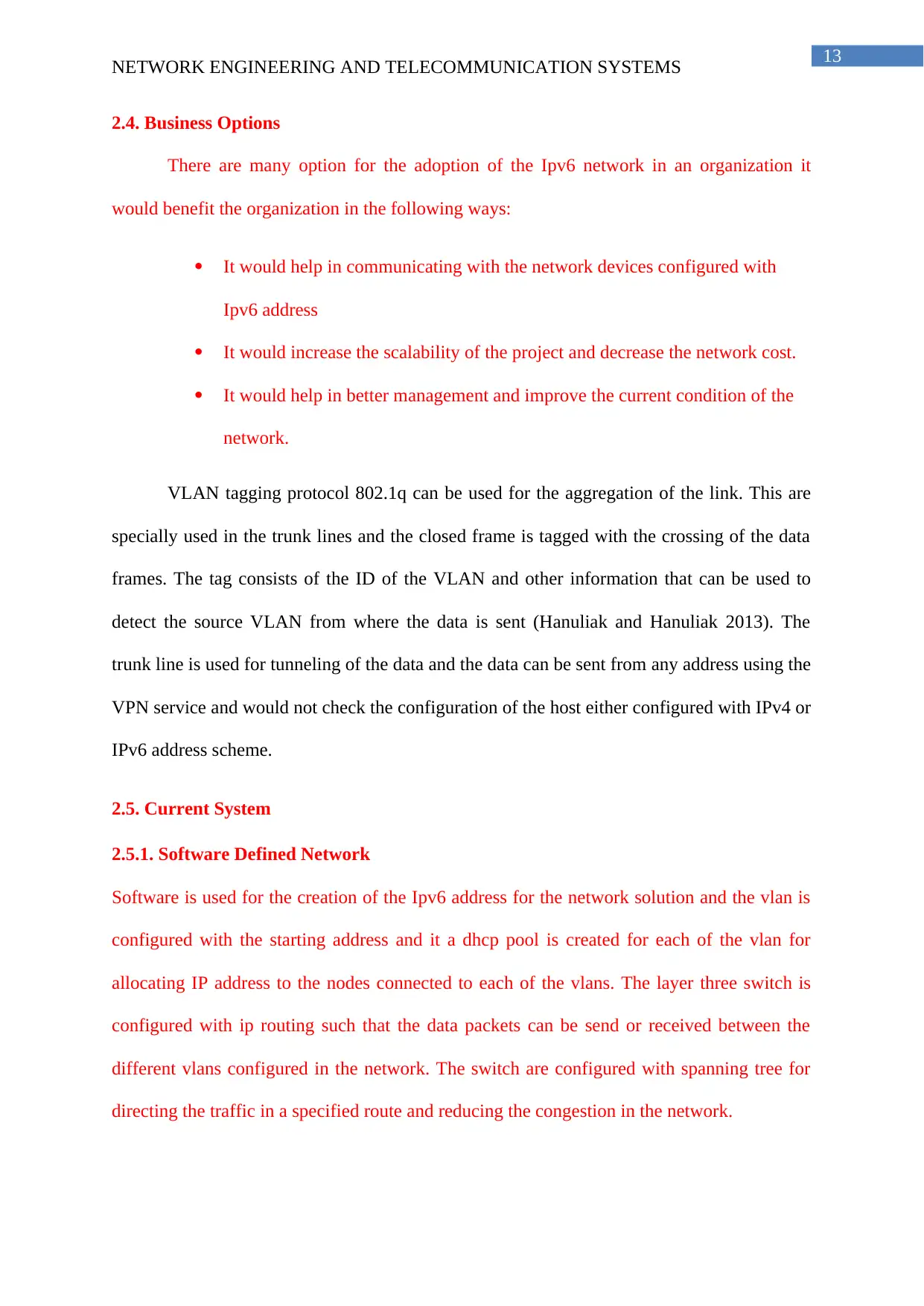
13
NETWORK ENGINEERING AND TELECOMMUNICATION SYSTEMS
2.4. Business Options
There are many option for the adoption of the Ipv6 network in an organization it
would benefit the organization in the following ways:
It would help in communicating with the network devices configured with
Ipv6 address
It would increase the scalability of the project and decrease the network cost.
It would help in better management and improve the current condition of the
network.
VLAN tagging protocol 802.1q can be used for the aggregation of the link. This are
specially used in the trunk lines and the closed frame is tagged with the crossing of the data
frames. The tag consists of the ID of the VLAN and other information that can be used to
detect the source VLAN from where the data is sent (Hanuliak and Hanuliak 2013). The
trunk line is used for tunneling of the data and the data can be sent from any address using the
VPN service and would not check the configuration of the host either configured with IPv4 or
IPv6 address scheme.
2.5. Current System
2.5.1. Software Defined Network
Software is used for the creation of the Ipv6 address for the network solution and the vlan is
configured with the starting address and it a dhcp pool is created for each of the vlan for
allocating IP address to the nodes connected to each of the vlans. The layer three switch is
configured with ip routing such that the data packets can be send or received between the
different vlans configured in the network. The switch are configured with spanning tree for
directing the traffic in a specified route and reducing the congestion in the network.
NETWORK ENGINEERING AND TELECOMMUNICATION SYSTEMS
2.4. Business Options
There are many option for the adoption of the Ipv6 network in an organization it
would benefit the organization in the following ways:
It would help in communicating with the network devices configured with
Ipv6 address
It would increase the scalability of the project and decrease the network cost.
It would help in better management and improve the current condition of the
network.
VLAN tagging protocol 802.1q can be used for the aggregation of the link. This are
specially used in the trunk lines and the closed frame is tagged with the crossing of the data
frames. The tag consists of the ID of the VLAN and other information that can be used to
detect the source VLAN from where the data is sent (Hanuliak and Hanuliak 2013). The
trunk line is used for tunneling of the data and the data can be sent from any address using the
VPN service and would not check the configuration of the host either configured with IPv4 or
IPv6 address scheme.
2.5. Current System
2.5.1. Software Defined Network
Software is used for the creation of the Ipv6 address for the network solution and the vlan is
configured with the starting address and it a dhcp pool is created for each of the vlan for
allocating IP address to the nodes connected to each of the vlans. The layer three switch is
configured with ip routing such that the data packets can be send or received between the
different vlans configured in the network. The switch are configured with spanning tree for
directing the traffic in a specified route and reducing the congestion in the network.
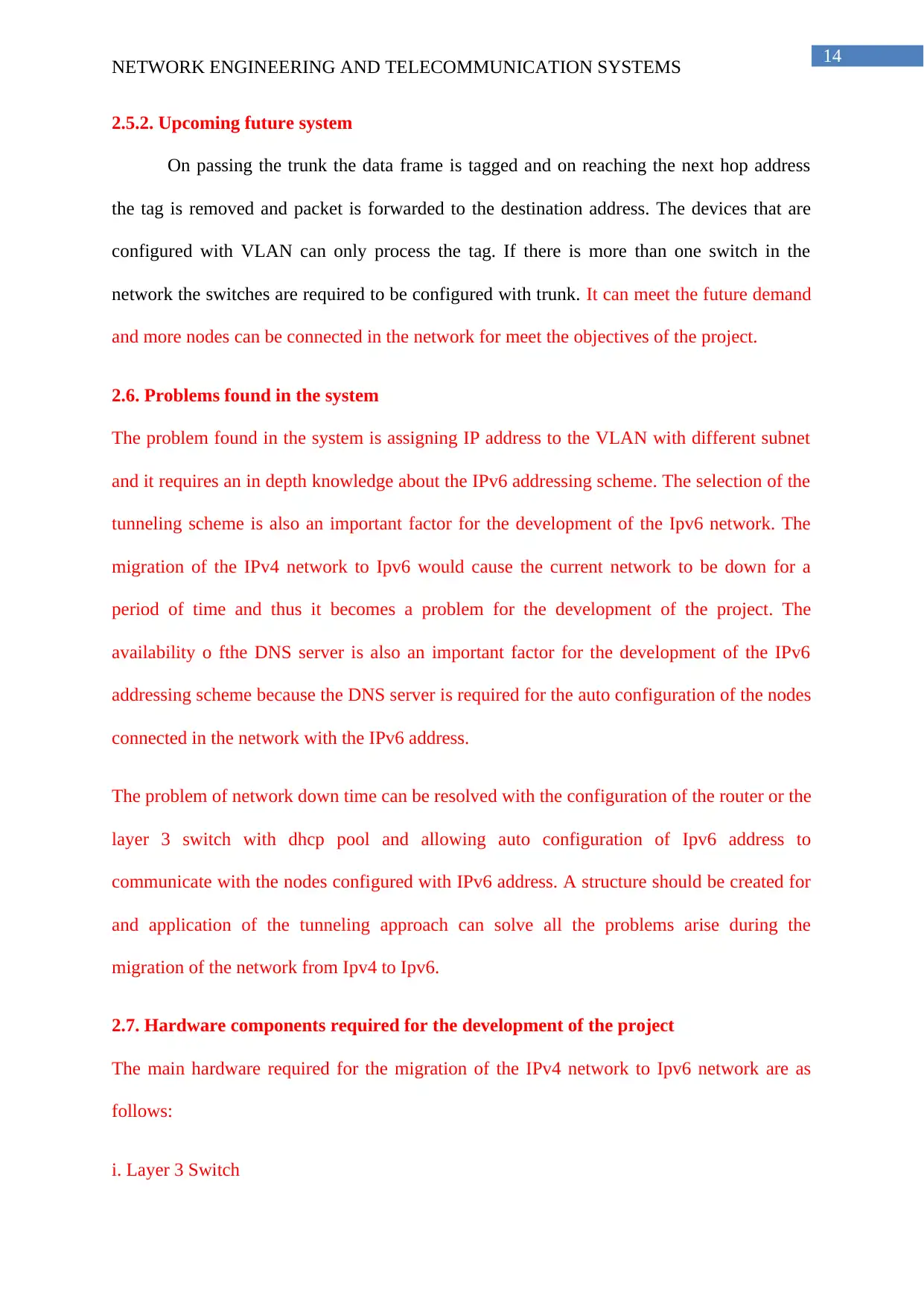
14
NETWORK ENGINEERING AND TELECOMMUNICATION SYSTEMS
2.5.2. Upcoming future system
On passing the trunk the data frame is tagged and on reaching the next hop address
the tag is removed and packet is forwarded to the destination address. The devices that are
configured with VLAN can only process the tag. If there is more than one switch in the
network the switches are required to be configured with trunk. It can meet the future demand
and more nodes can be connected in the network for meet the objectives of the project.
2.6. Problems found in the system
The problem found in the system is assigning IP address to the VLAN with different subnet
and it requires an in depth knowledge about the IPv6 addressing scheme. The selection of the
tunneling scheme is also an important factor for the development of the Ipv6 network. The
migration of the IPv4 network to Ipv6 would cause the current network to be down for a
period of time and thus it becomes a problem for the development of the project. The
availability o fthe DNS server is also an important factor for the development of the IPv6
addressing scheme because the DNS server is required for the auto configuration of the nodes
connected in the network with the IPv6 address.
The problem of network down time can be resolved with the configuration of the router or the
layer 3 switch with dhcp pool and allowing auto configuration of Ipv6 address to
communicate with the nodes configured with IPv6 address. A structure should be created for
and application of the tunneling approach can solve all the problems arise during the
migration of the network from Ipv4 to Ipv6.
2.7. Hardware components required for the development of the project
The main hardware required for the migration of the IPv4 network to Ipv6 network are as
follows:
i. Layer 3 Switch
NETWORK ENGINEERING AND TELECOMMUNICATION SYSTEMS
2.5.2. Upcoming future system
On passing the trunk the data frame is tagged and on reaching the next hop address
the tag is removed and packet is forwarded to the destination address. The devices that are
configured with VLAN can only process the tag. If there is more than one switch in the
network the switches are required to be configured with trunk. It can meet the future demand
and more nodes can be connected in the network for meet the objectives of the project.
2.6. Problems found in the system
The problem found in the system is assigning IP address to the VLAN with different subnet
and it requires an in depth knowledge about the IPv6 addressing scheme. The selection of the
tunneling scheme is also an important factor for the development of the Ipv6 network. The
migration of the IPv4 network to Ipv6 would cause the current network to be down for a
period of time and thus it becomes a problem for the development of the project. The
availability o fthe DNS server is also an important factor for the development of the IPv6
addressing scheme because the DNS server is required for the auto configuration of the nodes
connected in the network with the IPv6 address.
The problem of network down time can be resolved with the configuration of the router or the
layer 3 switch with dhcp pool and allowing auto configuration of Ipv6 address to
communicate with the nodes configured with IPv6 address. A structure should be created for
and application of the tunneling approach can solve all the problems arise during the
migration of the network from Ipv4 to Ipv6.
2.7. Hardware components required for the development of the project
The main hardware required for the migration of the IPv4 network to Ipv6 network are as
follows:
i. Layer 3 Switch
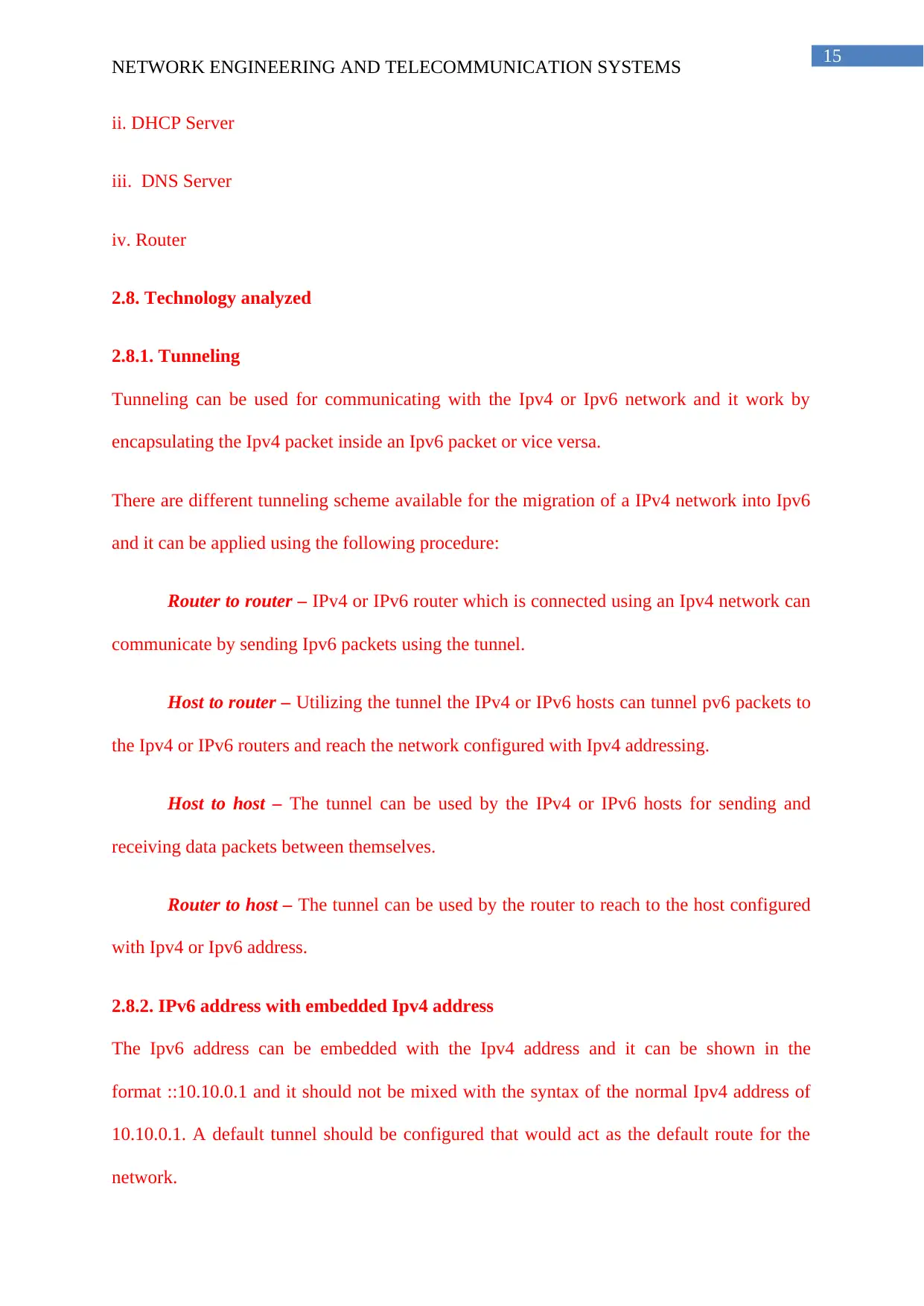
15
NETWORK ENGINEERING AND TELECOMMUNICATION SYSTEMS
ii. DHCP Server
iii. DNS Server
iv. Router
2.8. Technology analyzed
2.8.1. Tunneling
Tunneling can be used for communicating with the Ipv4 or Ipv6 network and it work by
encapsulating the Ipv4 packet inside an Ipv6 packet or vice versa.
There are different tunneling scheme available for the migration of a IPv4 network into Ipv6
and it can be applied using the following procedure:
Router to router – IPv4 or IPv6 router which is connected using an Ipv4 network can
communicate by sending Ipv6 packets using the tunnel.
Host to router – Utilizing the tunnel the IPv4 or IPv6 hosts can tunnel pv6 packets to
the Ipv4 or IPv6 routers and reach the network configured with Ipv4 addressing.
Host to host – The tunnel can be used by the IPv4 or IPv6 hosts for sending and
receiving data packets between themselves.
Router to host – The tunnel can be used by the router to reach to the host configured
with Ipv4 or Ipv6 address.
2.8.2. IPv6 address with embedded Ipv4 address
The Ipv6 address can be embedded with the Ipv4 address and it can be shown in the
format ::10.10.0.1 and it should not be mixed with the syntax of the normal Ipv4 address of
10.10.0.1. A default tunnel should be configured that would act as the default route for the
network.
NETWORK ENGINEERING AND TELECOMMUNICATION SYSTEMS
ii. DHCP Server
iii. DNS Server
iv. Router
2.8. Technology analyzed
2.8.1. Tunneling
Tunneling can be used for communicating with the Ipv4 or Ipv6 network and it work by
encapsulating the Ipv4 packet inside an Ipv6 packet or vice versa.
There are different tunneling scheme available for the migration of a IPv4 network into Ipv6
and it can be applied using the following procedure:
Router to router – IPv4 or IPv6 router which is connected using an Ipv4 network can
communicate by sending Ipv6 packets using the tunnel.
Host to router – Utilizing the tunnel the IPv4 or IPv6 hosts can tunnel pv6 packets to
the Ipv4 or IPv6 routers and reach the network configured with Ipv4 addressing.
Host to host – The tunnel can be used by the IPv4 or IPv6 hosts for sending and
receiving data packets between themselves.
Router to host – The tunnel can be used by the router to reach to the host configured
with Ipv4 or Ipv6 address.
2.8.2. IPv6 address with embedded Ipv4 address
The Ipv6 address can be embedded with the Ipv4 address and it can be shown in the
format ::10.10.0.1 and it should not be mixed with the syntax of the normal Ipv4 address of
10.10.0.1. A default tunnel should be configured that would act as the default route for the
network.
Secure Best Marks with AI Grader
Need help grading? Try our AI Grader for instant feedback on your assignments.
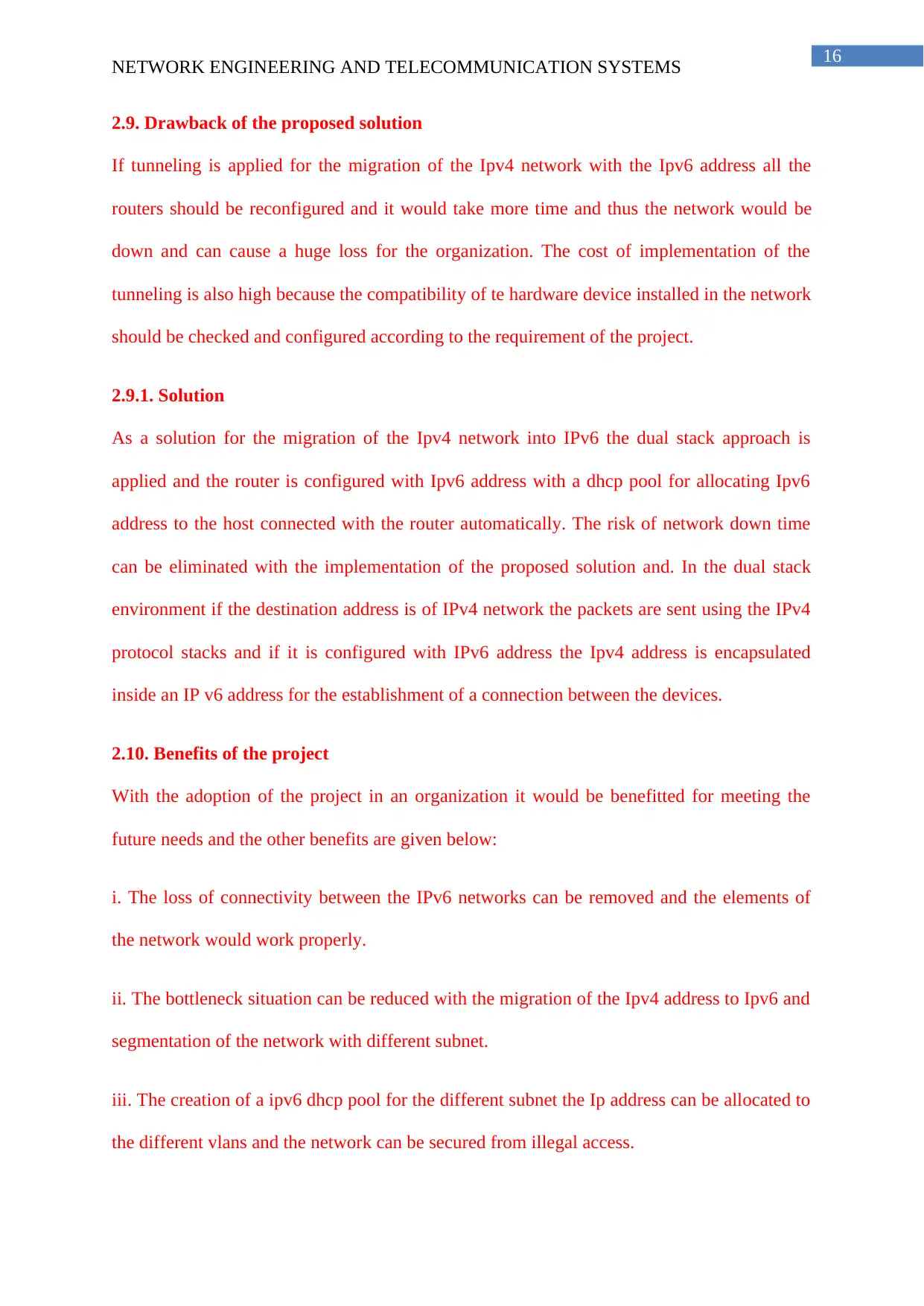
16
NETWORK ENGINEERING AND TELECOMMUNICATION SYSTEMS
2.9. Drawback of the proposed solution
If tunneling is applied for the migration of the Ipv4 network with the Ipv6 address all the
routers should be reconfigured and it would take more time and thus the network would be
down and can cause a huge loss for the organization. The cost of implementation of the
tunneling is also high because the compatibility of te hardware device installed in the network
should be checked and configured according to the requirement of the project.
2.9.1. Solution
As a solution for the migration of the Ipv4 network into IPv6 the dual stack approach is
applied and the router is configured with Ipv6 address with a dhcp pool for allocating Ipv6
address to the host connected with the router automatically. The risk of network down time
can be eliminated with the implementation of the proposed solution and. In the dual stack
environment if the destination address is of IPv4 network the packets are sent using the IPv4
protocol stacks and if it is configured with IPv6 address the Ipv4 address is encapsulated
inside an IP v6 address for the establishment of a connection between the devices.
2.10. Benefits of the project
With the adoption of the project in an organization it would be benefitted for meeting the
future needs and the other benefits are given below:
i. The loss of connectivity between the IPv6 networks can be removed and the elements of
the network would work properly.
ii. The bottleneck situation can be reduced with the migration of the Ipv4 address to Ipv6 and
segmentation of the network with different subnet.
iii. The creation of a ipv6 dhcp pool for the different subnet the Ip address can be allocated to
the different vlans and the network can be secured from illegal access.
NETWORK ENGINEERING AND TELECOMMUNICATION SYSTEMS
2.9. Drawback of the proposed solution
If tunneling is applied for the migration of the Ipv4 network with the Ipv6 address all the
routers should be reconfigured and it would take more time and thus the network would be
down and can cause a huge loss for the organization. The cost of implementation of the
tunneling is also high because the compatibility of te hardware device installed in the network
should be checked and configured according to the requirement of the project.
2.9.1. Solution
As a solution for the migration of the Ipv4 network into IPv6 the dual stack approach is
applied and the router is configured with Ipv6 address with a dhcp pool for allocating Ipv6
address to the host connected with the router automatically. The risk of network down time
can be eliminated with the implementation of the proposed solution and. In the dual stack
environment if the destination address is of IPv4 network the packets are sent using the IPv4
protocol stacks and if it is configured with IPv6 address the Ipv4 address is encapsulated
inside an IP v6 address for the establishment of a connection between the devices.
2.10. Benefits of the project
With the adoption of the project in an organization it would be benefitted for meeting the
future needs and the other benefits are given below:
i. The loss of connectivity between the IPv6 networks can be removed and the elements of
the network would work properly.
ii. The bottleneck situation can be reduced with the migration of the Ipv4 address to Ipv6 and
segmentation of the network with different subnet.
iii. The creation of a ipv6 dhcp pool for the different subnet the Ip address can be allocated to
the different vlans and the network can be secured from illegal access.
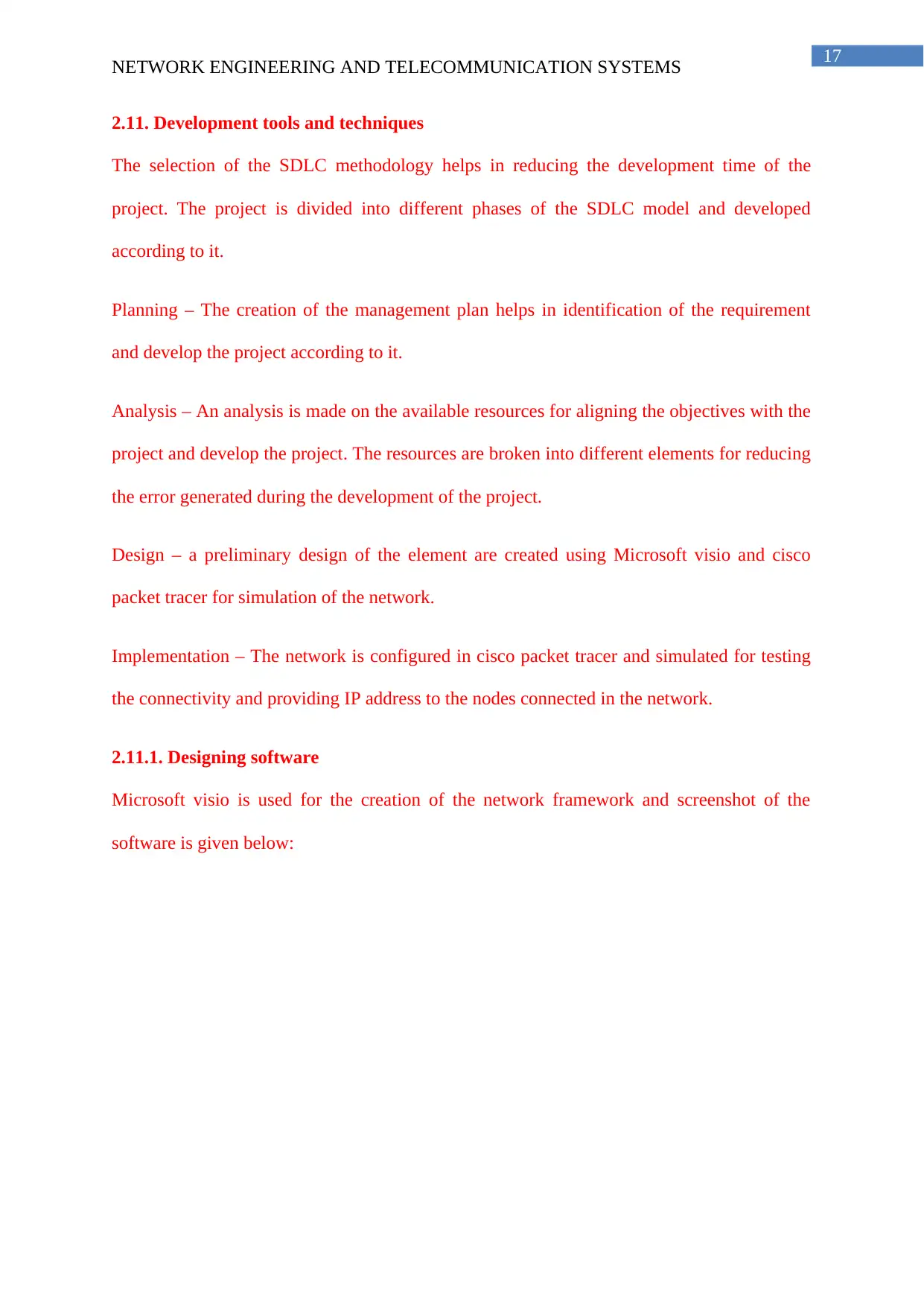
17
NETWORK ENGINEERING AND TELECOMMUNICATION SYSTEMS
2.11. Development tools and techniques
The selection of the SDLC methodology helps in reducing the development time of the
project. The project is divided into different phases of the SDLC model and developed
according to it.
Planning – The creation of the management plan helps in identification of the requirement
and develop the project according to it.
Analysis – An analysis is made on the available resources for aligning the objectives with the
project and develop the project. The resources are broken into different elements for reducing
the error generated during the development of the project.
Design – a preliminary design of the element are created using Microsoft visio and cisco
packet tracer for simulation of the network.
Implementation – The network is configured in cisco packet tracer and simulated for testing
the connectivity and providing IP address to the nodes connected in the network.
2.11.1. Designing software
Microsoft visio is used for the creation of the network framework and screenshot of the
software is given below:
NETWORK ENGINEERING AND TELECOMMUNICATION SYSTEMS
2.11. Development tools and techniques
The selection of the SDLC methodology helps in reducing the development time of the
project. The project is divided into different phases of the SDLC model and developed
according to it.
Planning – The creation of the management plan helps in identification of the requirement
and develop the project according to it.
Analysis – An analysis is made on the available resources for aligning the objectives with the
project and develop the project. The resources are broken into different elements for reducing
the error generated during the development of the project.
Design – a preliminary design of the element are created using Microsoft visio and cisco
packet tracer for simulation of the network.
Implementation – The network is configured in cisco packet tracer and simulated for testing
the connectivity and providing IP address to the nodes connected in the network.
2.11.1. Designing software
Microsoft visio is used for the creation of the network framework and screenshot of the
software is given below:
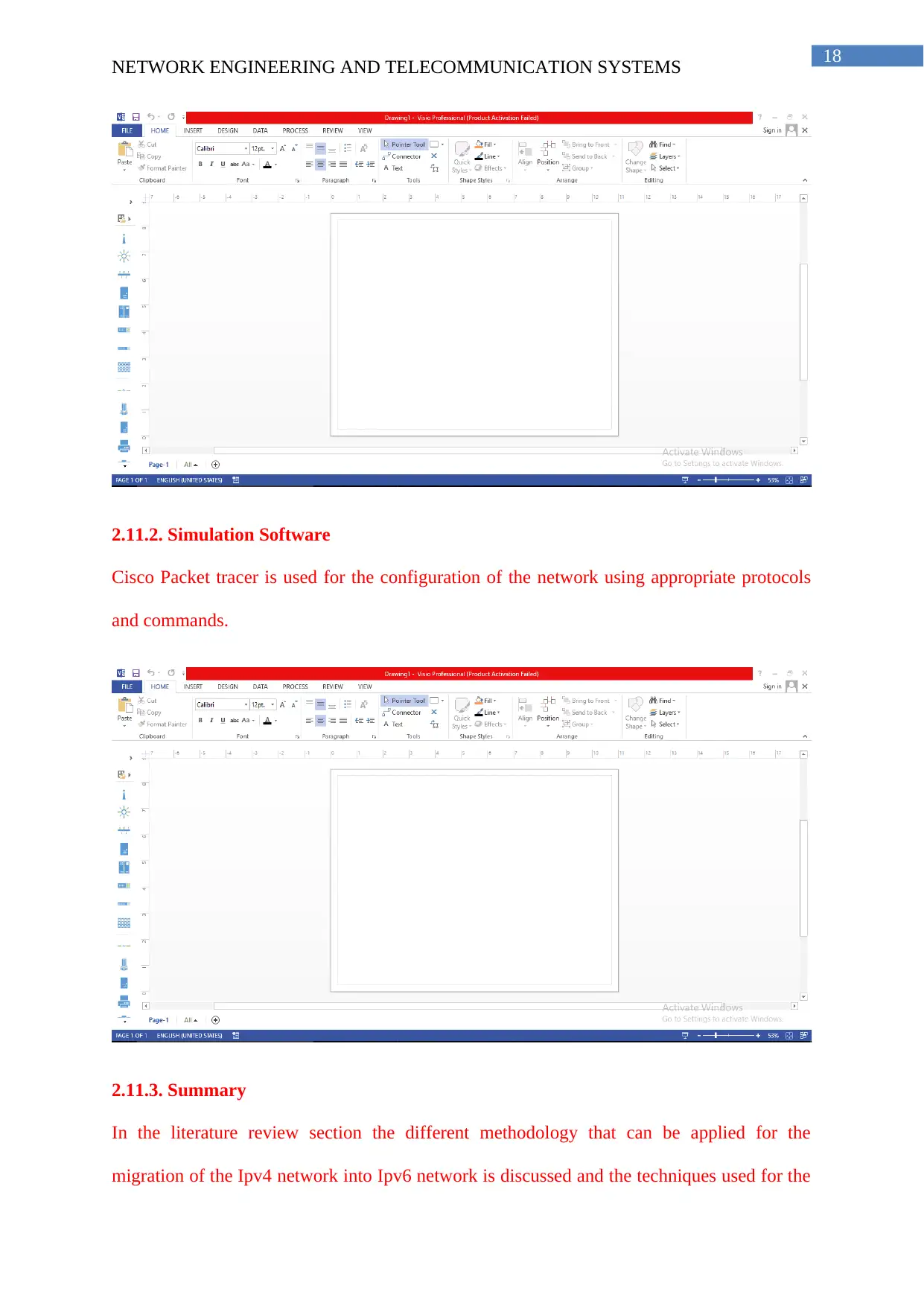
18
NETWORK ENGINEERING AND TELECOMMUNICATION SYSTEMS
2.11.2. Simulation Software
Cisco Packet tracer is used for the configuration of the network using appropriate protocols
and commands.
2.11.3. Summary
In the literature review section the different methodology that can be applied for the
migration of the Ipv4 network into Ipv6 network is discussed and the techniques used for the
NETWORK ENGINEERING AND TELECOMMUNICATION SYSTEMS
2.11.2. Simulation Software
Cisco Packet tracer is used for the configuration of the network using appropriate protocols
and commands.
2.11.3. Summary
In the literature review section the different methodology that can be applied for the
migration of the Ipv4 network into Ipv6 network is discussed and the techniques used for the
Paraphrase This Document
Need a fresh take? Get an instant paraphrase of this document with our AI Paraphraser
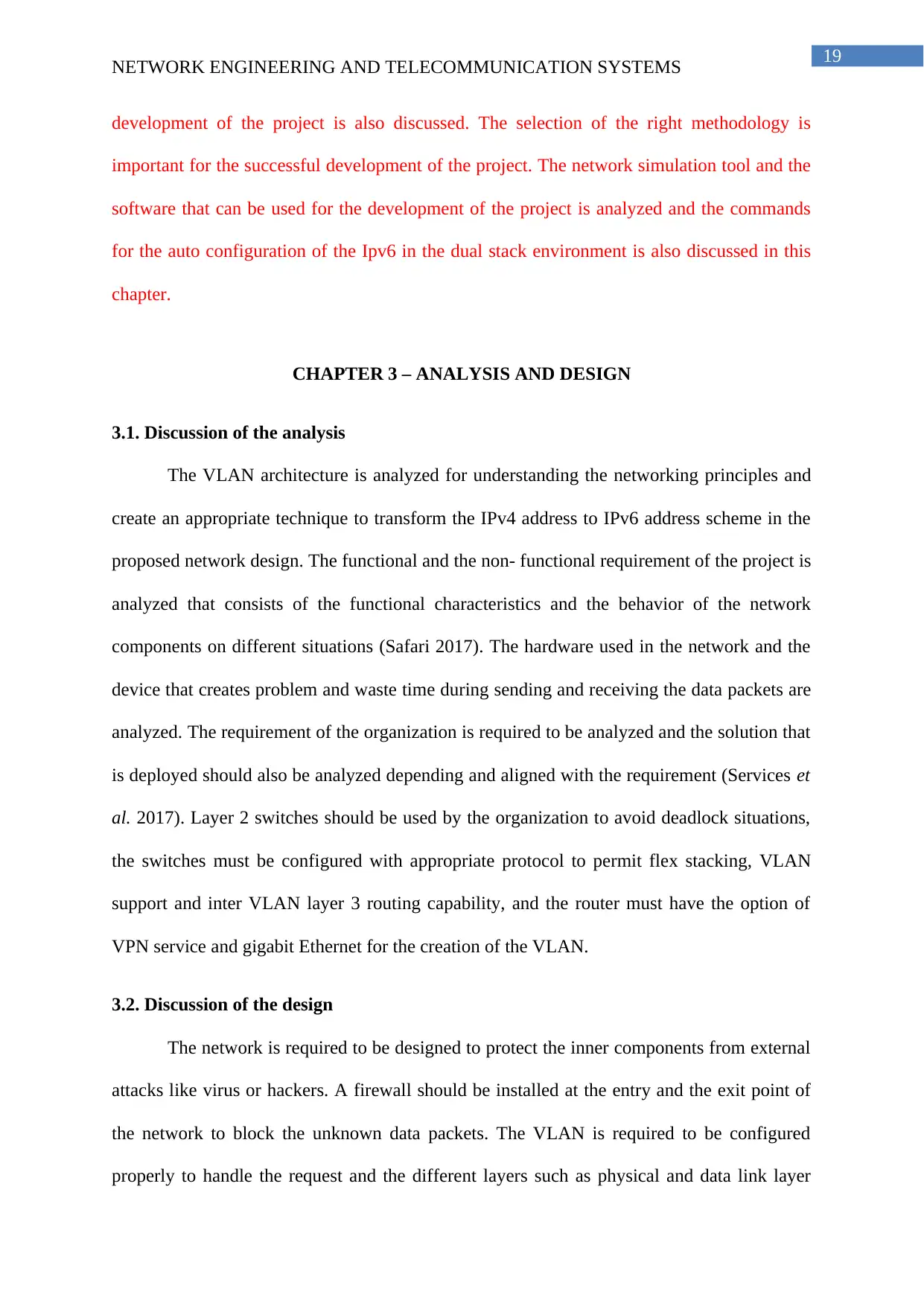
19
NETWORK ENGINEERING AND TELECOMMUNICATION SYSTEMS
development of the project is also discussed. The selection of the right methodology is
important for the successful development of the project. The network simulation tool and the
software that can be used for the development of the project is analyzed and the commands
for the auto configuration of the Ipv6 in the dual stack environment is also discussed in this
chapter.
CHAPTER 3 – ANALYSIS AND DESIGN
3.1. Discussion of the analysis
The VLAN architecture is analyzed for understanding the networking principles and
create an appropriate technique to transform the IPv4 address to IPv6 address scheme in the
proposed network design. The functional and the non- functional requirement of the project is
analyzed that consists of the functional characteristics and the behavior of the network
components on different situations (Safari 2017). The hardware used in the network and the
device that creates problem and waste time during sending and receiving the data packets are
analyzed. The requirement of the organization is required to be analyzed and the solution that
is deployed should also be analyzed depending and aligned with the requirement (Services et
al. 2017). Layer 2 switches should be used by the organization to avoid deadlock situations,
the switches must be configured with appropriate protocol to permit flex stacking, VLAN
support and inter VLAN layer 3 routing capability, and the router must have the option of
VPN service and gigabit Ethernet for the creation of the VLAN.
3.2. Discussion of the design
The network is required to be designed to protect the inner components from external
attacks like virus or hackers. A firewall should be installed at the entry and the exit point of
the network to block the unknown data packets. The VLAN is required to be configured
properly to handle the request and the different layers such as physical and data link layer
NETWORK ENGINEERING AND TELECOMMUNICATION SYSTEMS
development of the project is also discussed. The selection of the right methodology is
important for the successful development of the project. The network simulation tool and the
software that can be used for the development of the project is analyzed and the commands
for the auto configuration of the Ipv6 in the dual stack environment is also discussed in this
chapter.
CHAPTER 3 – ANALYSIS AND DESIGN
3.1. Discussion of the analysis
The VLAN architecture is analyzed for understanding the networking principles and
create an appropriate technique to transform the IPv4 address to IPv6 address scheme in the
proposed network design. The functional and the non- functional requirement of the project is
analyzed that consists of the functional characteristics and the behavior of the network
components on different situations (Safari 2017). The hardware used in the network and the
device that creates problem and waste time during sending and receiving the data packets are
analyzed. The requirement of the organization is required to be analyzed and the solution that
is deployed should also be analyzed depending and aligned with the requirement (Services et
al. 2017). Layer 2 switches should be used by the organization to avoid deadlock situations,
the switches must be configured with appropriate protocol to permit flex stacking, VLAN
support and inter VLAN layer 3 routing capability, and the router must have the option of
VPN service and gigabit Ethernet for the creation of the VLAN.
3.2. Discussion of the design
The network is required to be designed to protect the inner components from external
attacks like virus or hackers. A firewall should be installed at the entry and the exit point of
the network to block the unknown data packets. The VLAN is required to be configured
properly to handle the request and the different layers such as physical and data link layer
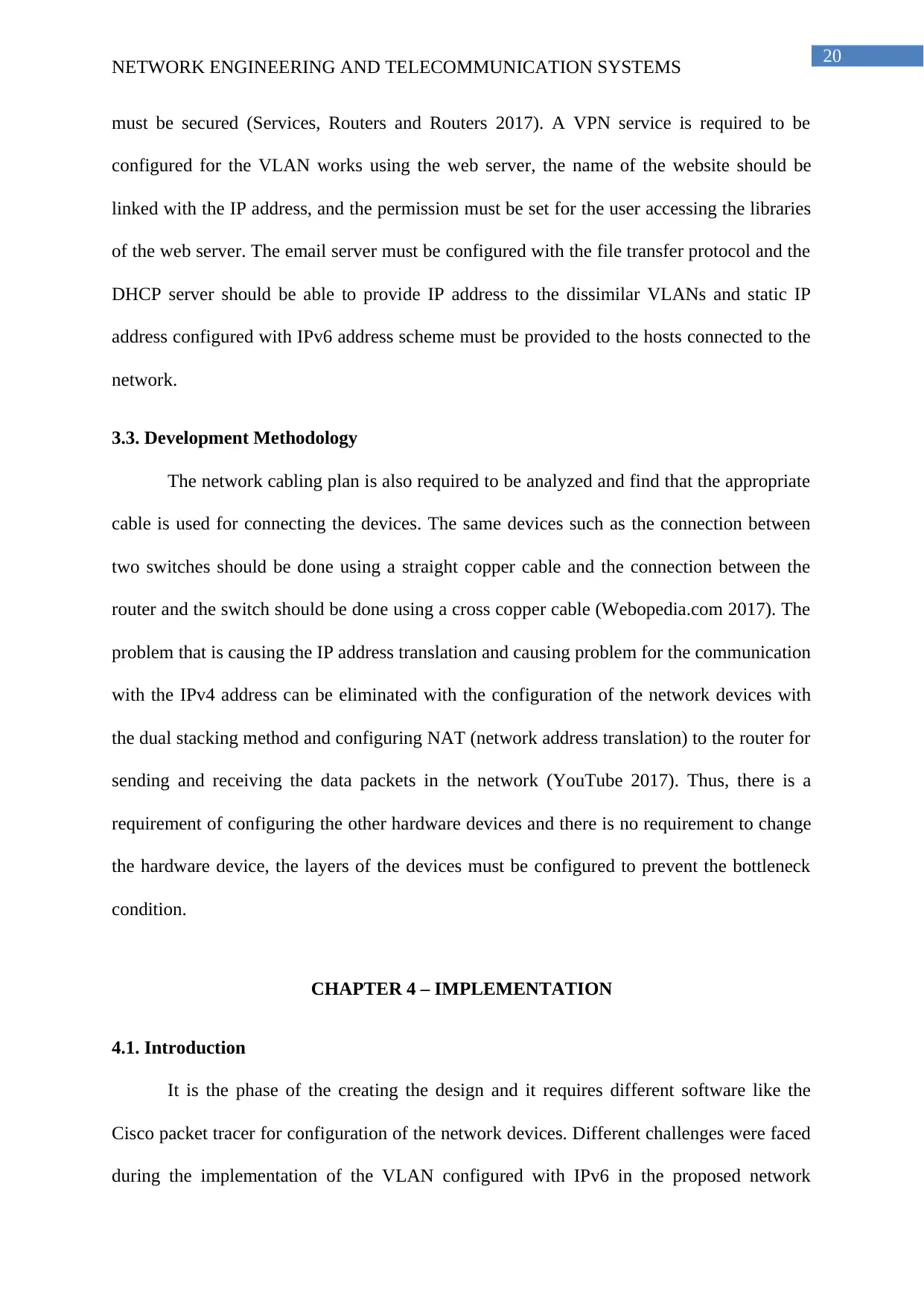
20
NETWORK ENGINEERING AND TELECOMMUNICATION SYSTEMS
must be secured (Services, Routers and Routers 2017). A VPN service is required to be
configured for the VLAN works using the web server, the name of the website should be
linked with the IP address, and the permission must be set for the user accessing the libraries
of the web server. The email server must be configured with the file transfer protocol and the
DHCP server should be able to provide IP address to the dissimilar VLANs and static IP
address configured with IPv6 address scheme must be provided to the hosts connected to the
network.
3.3. Development Methodology
The network cabling plan is also required to be analyzed and find that the appropriate
cable is used for connecting the devices. The same devices such as the connection between
two switches should be done using a straight copper cable and the connection between the
router and the switch should be done using a cross copper cable (Webopedia.com 2017). The
problem that is causing the IP address translation and causing problem for the communication
with the IPv4 address can be eliminated with the configuration of the network devices with
the dual stacking method and configuring NAT (network address translation) to the router for
sending and receiving the data packets in the network (YouTube 2017). Thus, there is a
requirement of configuring the other hardware devices and there is no requirement to change
the hardware device, the layers of the devices must be configured to prevent the bottleneck
condition.
CHAPTER 4 – IMPLEMENTATION
4.1. Introduction
It is the phase of the creating the design and it requires different software like the
Cisco packet tracer for configuration of the network devices. Different challenges were faced
during the implementation of the VLAN configured with IPv6 in the proposed network
NETWORK ENGINEERING AND TELECOMMUNICATION SYSTEMS
must be secured (Services, Routers and Routers 2017). A VPN service is required to be
configured for the VLAN works using the web server, the name of the website should be
linked with the IP address, and the permission must be set for the user accessing the libraries
of the web server. The email server must be configured with the file transfer protocol and the
DHCP server should be able to provide IP address to the dissimilar VLANs and static IP
address configured with IPv6 address scheme must be provided to the hosts connected to the
network.
3.3. Development Methodology
The network cabling plan is also required to be analyzed and find that the appropriate
cable is used for connecting the devices. The same devices such as the connection between
two switches should be done using a straight copper cable and the connection between the
router and the switch should be done using a cross copper cable (Webopedia.com 2017). The
problem that is causing the IP address translation and causing problem for the communication
with the IPv4 address can be eliminated with the configuration of the network devices with
the dual stacking method and configuring NAT (network address translation) to the router for
sending and receiving the data packets in the network (YouTube 2017). Thus, there is a
requirement of configuring the other hardware devices and there is no requirement to change
the hardware device, the layers of the devices must be configured to prevent the bottleneck
condition.
CHAPTER 4 – IMPLEMENTATION
4.1. Introduction
It is the phase of the creating the design and it requires different software like the
Cisco packet tracer for configuration of the network devices. Different challenges were faced
during the implementation of the VLAN configured with IPv6 in the proposed network
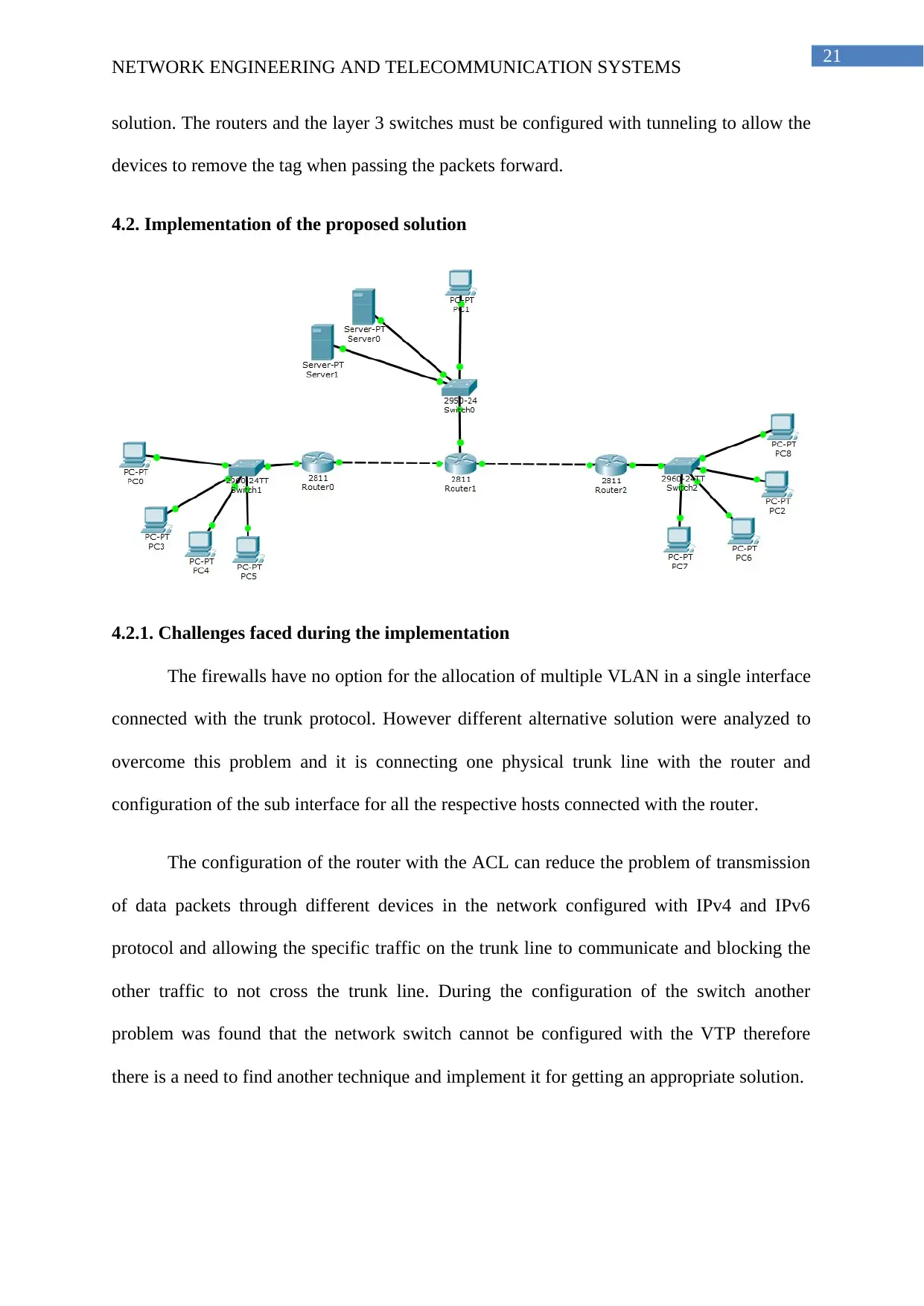
21
NETWORK ENGINEERING AND TELECOMMUNICATION SYSTEMS
solution. The routers and the layer 3 switches must be configured with tunneling to allow the
devices to remove the tag when passing the packets forward.
4.2. Implementation of the proposed solution
4.2.1. Challenges faced during the implementation
The firewalls have no option for the allocation of multiple VLAN in a single interface
connected with the trunk protocol. However different alternative solution were analyzed to
overcome this problem and it is connecting one physical trunk line with the router and
configuration of the sub interface for all the respective hosts connected with the router.
The configuration of the router with the ACL can reduce the problem of transmission
of data packets through different devices in the network configured with IPv4 and IPv6
protocol and allowing the specific traffic on the trunk line to communicate and blocking the
other traffic to not cross the trunk line. During the configuration of the switch another
problem was found that the network switch cannot be configured with the VTP therefore
there is a need to find another technique and implement it for getting an appropriate solution.
NETWORK ENGINEERING AND TELECOMMUNICATION SYSTEMS
solution. The routers and the layer 3 switches must be configured with tunneling to allow the
devices to remove the tag when passing the packets forward.
4.2. Implementation of the proposed solution
4.2.1. Challenges faced during the implementation
The firewalls have no option for the allocation of multiple VLAN in a single interface
connected with the trunk protocol. However different alternative solution were analyzed to
overcome this problem and it is connecting one physical trunk line with the router and
configuration of the sub interface for all the respective hosts connected with the router.
The configuration of the router with the ACL can reduce the problem of transmission
of data packets through different devices in the network configured with IPv4 and IPv6
protocol and allowing the specific traffic on the trunk line to communicate and blocking the
other traffic to not cross the trunk line. During the configuration of the switch another
problem was found that the network switch cannot be configured with the VTP therefore
there is a need to find another technique and implement it for getting an appropriate solution.
Secure Best Marks with AI Grader
Need help grading? Try our AI Grader for instant feedback on your assignments.
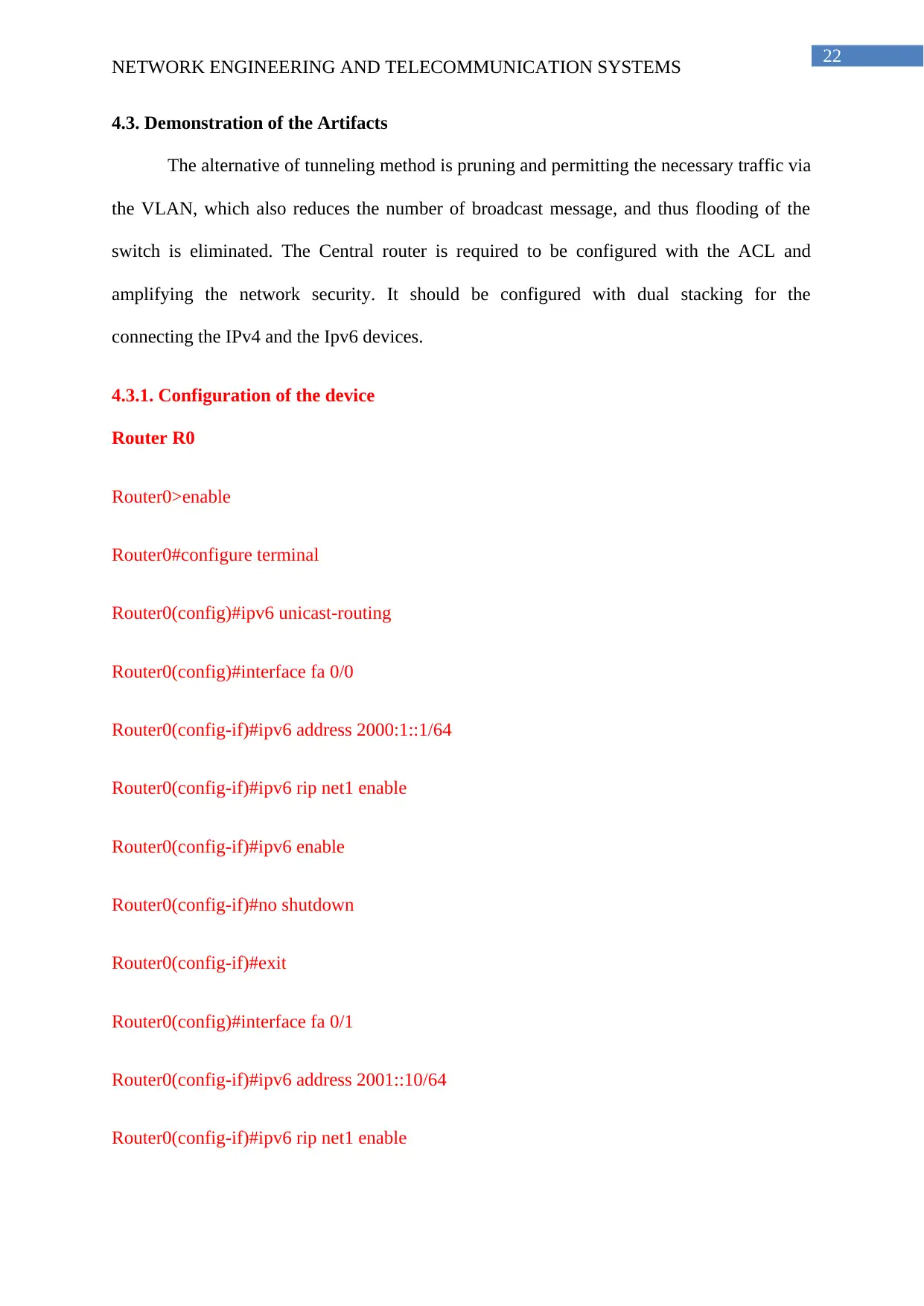
22
NETWORK ENGINEERING AND TELECOMMUNICATION SYSTEMS
4.3. Demonstration of the Artifacts
The alternative of tunneling method is pruning and permitting the necessary traffic via
the VLAN, which also reduces the number of broadcast message, and thus flooding of the
switch is eliminated. The Central router is required to be configured with the ACL and
amplifying the network security. It should be configured with dual stacking for the
connecting the IPv4 and the Ipv6 devices.
4.3.1. Configuration of the device
Router R0
Router0>enable
Router0#configure terminal
Router0(config)#ipv6 unicast-routing
Router0(config)#interface fa 0/0
Router0(config-if)#ipv6 address 2000:1::1/64
Router0(config-if)#ipv6 rip net1 enable
Router0(config-if)#ipv6 enable
Router0(config-if)#no shutdown
Router0(config-if)#exit
Router0(config)#interface fa 0/1
Router0(config-if)#ipv6 address 2001::10/64
Router0(config-if)#ipv6 rip net1 enable
NETWORK ENGINEERING AND TELECOMMUNICATION SYSTEMS
4.3. Demonstration of the Artifacts
The alternative of tunneling method is pruning and permitting the necessary traffic via
the VLAN, which also reduces the number of broadcast message, and thus flooding of the
switch is eliminated. The Central router is required to be configured with the ACL and
amplifying the network security. It should be configured with dual stacking for the
connecting the IPv4 and the Ipv6 devices.
4.3.1. Configuration of the device
Router R0
Router0>enable
Router0#configure terminal
Router0(config)#ipv6 unicast-routing
Router0(config)#interface fa 0/0
Router0(config-if)#ipv6 address 2000:1::1/64
Router0(config-if)#ipv6 rip net1 enable
Router0(config-if)#ipv6 enable
Router0(config-if)#no shutdown
Router0(config-if)#exit
Router0(config)#interface fa 0/1
Router0(config-if)#ipv6 address 2001::10/64
Router0(config-if)#ipv6 rip net1 enable

23
NETWORK ENGINEERING AND TELECOMMUNICATION SYSTEMS
Router0(config-if)#ipv6 enable
Router0(config-if)#no shutdown
Router0(config-if)#exit
Router R1
Router1>enable
Router1#configure terminal
Router1(config)#ipv6 unicast-routing
Router1(config)#interface fa 0/0
Router1(config-if)#ipv6 address 2000:2::1/64
Router1(config-if)#ipv6 rip net1 enable
Router1(config-if)#ipv6 enable
Router1(config-if)#no shutdown
Router1(config-if)#exit
Router1(config)#interface fa 0/1
Router1(config-if)#ipv6 address 2001::20/64
Router1(config-if)#ipv6 rip net1 enable
Router1(config-if)#ipv6 enable
Router1(config-if)#no shutdown
Router1(config-if)#exit
NETWORK ENGINEERING AND TELECOMMUNICATION SYSTEMS
Router0(config-if)#ipv6 enable
Router0(config-if)#no shutdown
Router0(config-if)#exit
Router R1
Router1>enable
Router1#configure terminal
Router1(config)#ipv6 unicast-routing
Router1(config)#interface fa 0/0
Router1(config-if)#ipv6 address 2000:2::1/64
Router1(config-if)#ipv6 rip net1 enable
Router1(config-if)#ipv6 enable
Router1(config-if)#no shutdown
Router1(config-if)#exit
Router1(config)#interface fa 0/1
Router1(config-if)#ipv6 address 2001::20/64
Router1(config-if)#ipv6 rip net1 enable
Router1(config-if)#ipv6 enable
Router1(config-if)#no shutdown
Router1(config-if)#exit

24
NETWORK ENGINEERING AND TELECOMMUNICATION SYSTEMS
Router1(config)#interface fa 1/0
Router1(config-if)#ipv6 address 2001:1::10/64
Router1(config-if)#ipv6 rip net1 enable
Router1(config-if)#ipv6 enable
Router1(config-if)#no shutdown
Router1(config-if)#exit
Router R2
Router2>enable
Router2#configure terminal
Router2(config)#ipv6 unicast-routing
Router2(config)#interface fa 0/0
Router2(config-if)#ipv6 address 2000:3::1/64
Router2(config-if)#ipv6 rip net1 enable
Router2(config-if)#ipv6 enable
Router2(config-if)#no shutdown
Router2(config-if)#exit
Router2(config)#interface fastEthernet 0/1
Router2(config-if)#ipv6 address 2001:1::20/64
Router2(config-if)#ipv6 rip net1 enable
NETWORK ENGINEERING AND TELECOMMUNICATION SYSTEMS
Router1(config)#interface fa 1/0
Router1(config-if)#ipv6 address 2001:1::10/64
Router1(config-if)#ipv6 rip net1 enable
Router1(config-if)#ipv6 enable
Router1(config-if)#no shutdown
Router1(config-if)#exit
Router R2
Router2>enable
Router2#configure terminal
Router2(config)#ipv6 unicast-routing
Router2(config)#interface fa 0/0
Router2(config-if)#ipv6 address 2000:3::1/64
Router2(config-if)#ipv6 rip net1 enable
Router2(config-if)#ipv6 enable
Router2(config-if)#no shutdown
Router2(config-if)#exit
Router2(config)#interface fastEthernet 0/1
Router2(config-if)#ipv6 address 2001:1::20/64
Router2(config-if)#ipv6 rip net1 enable
Paraphrase This Document
Need a fresh take? Get an instant paraphrase of this document with our AI Paraphraser
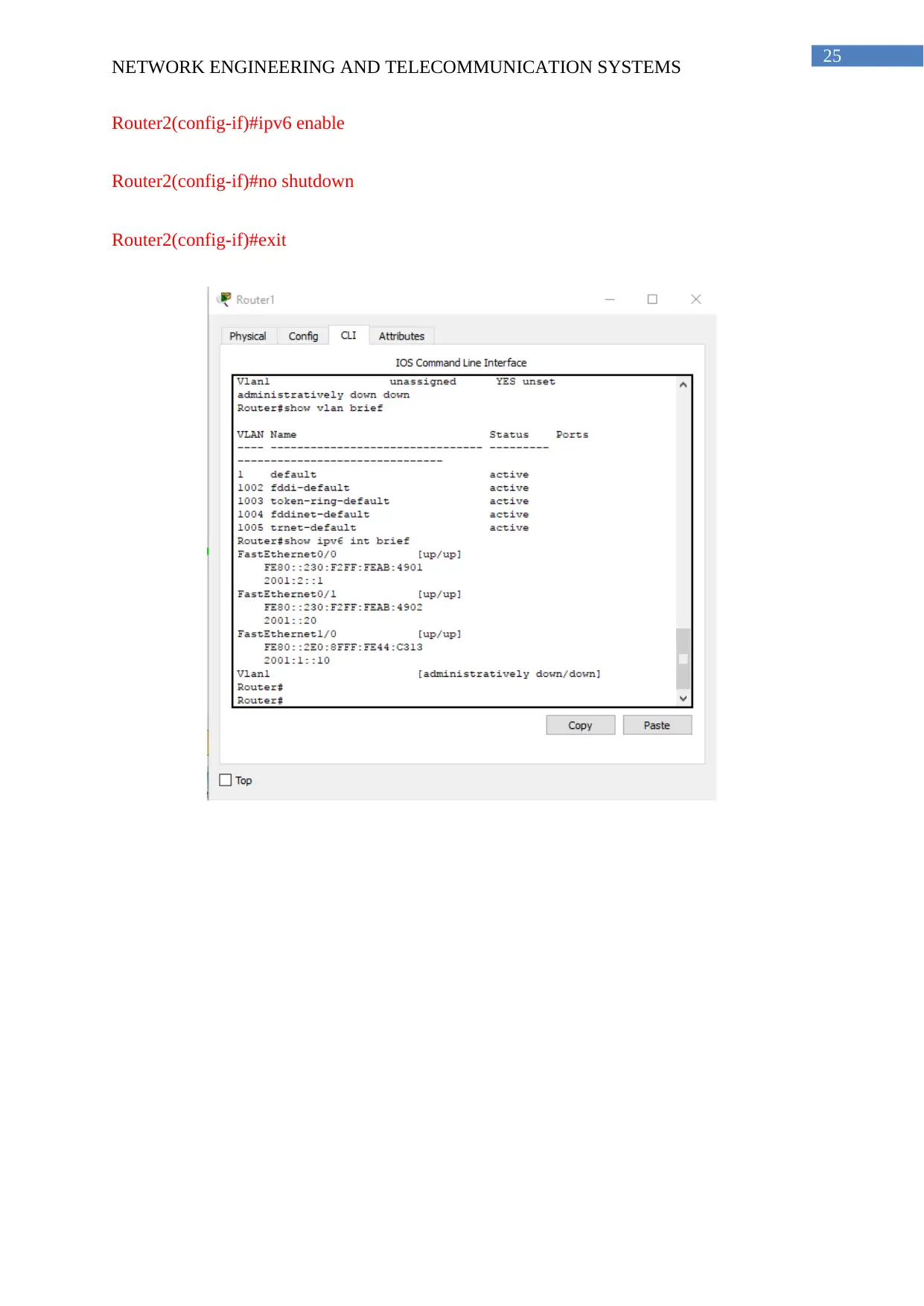
25
NETWORK ENGINEERING AND TELECOMMUNICATION SYSTEMS
Router2(config-if)#ipv6 enable
Router2(config-if)#no shutdown
Router2(config-if)#exit
NETWORK ENGINEERING AND TELECOMMUNICATION SYSTEMS
Router2(config-if)#ipv6 enable
Router2(config-if)#no shutdown
Router2(config-if)#exit
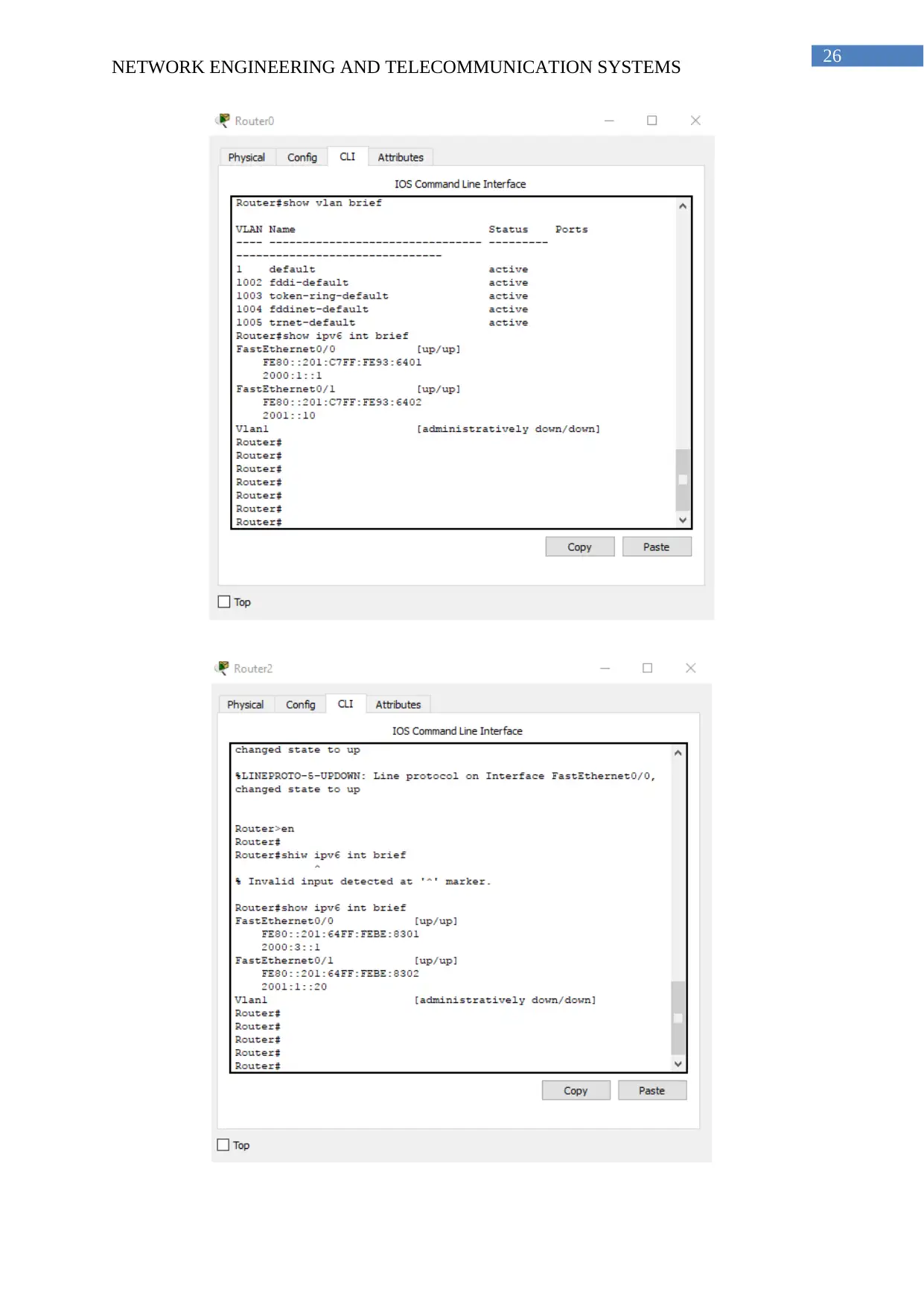
26
NETWORK ENGINEERING AND TELECOMMUNICATION SYSTEMS
NETWORK ENGINEERING AND TELECOMMUNICATION SYSTEMS
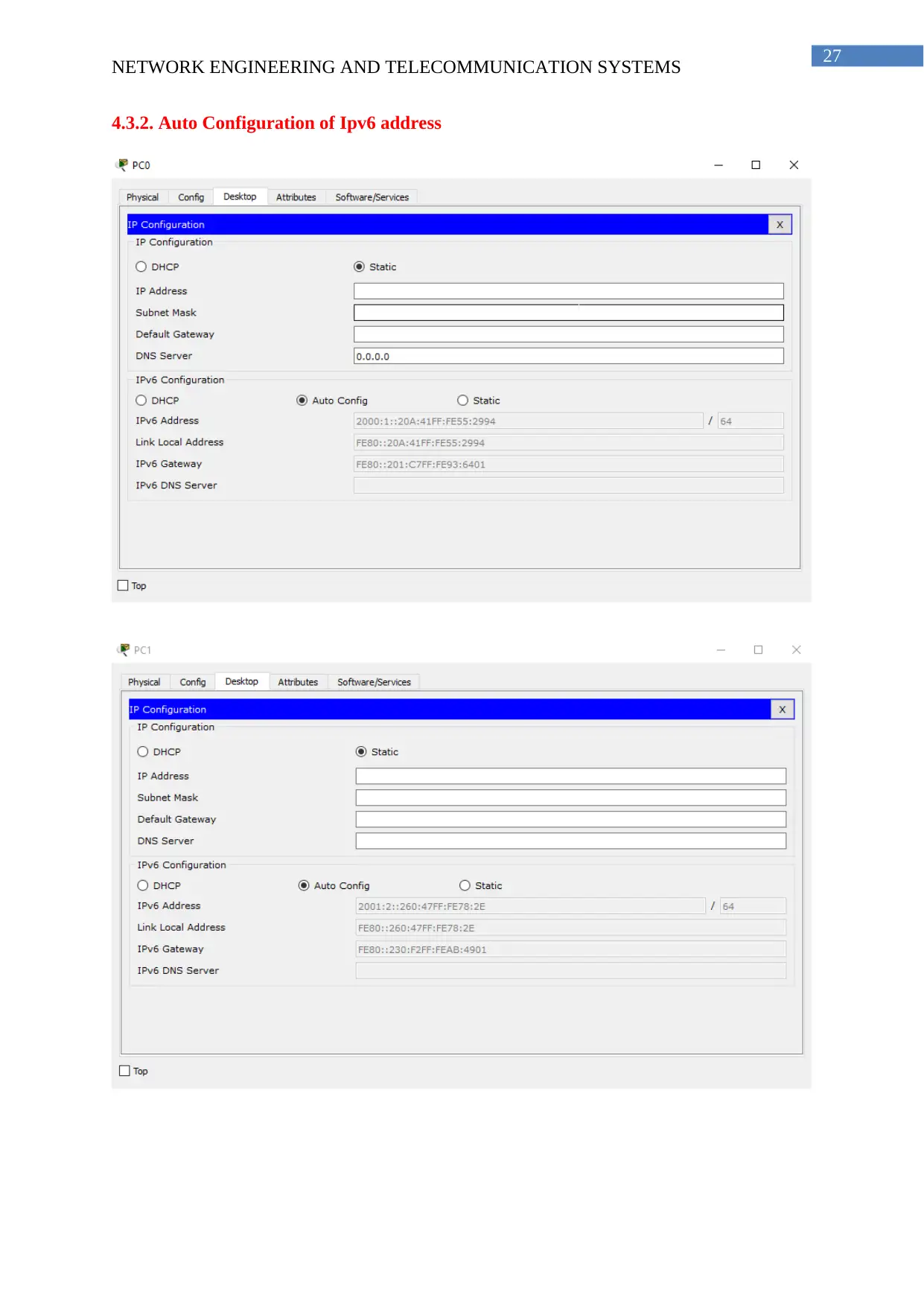
27
NETWORK ENGINEERING AND TELECOMMUNICATION SYSTEMS
4.3.2. Auto Configuration of Ipv6 address
NETWORK ENGINEERING AND TELECOMMUNICATION SYSTEMS
4.3.2. Auto Configuration of Ipv6 address
Secure Best Marks with AI Grader
Need help grading? Try our AI Grader for instant feedback on your assignments.
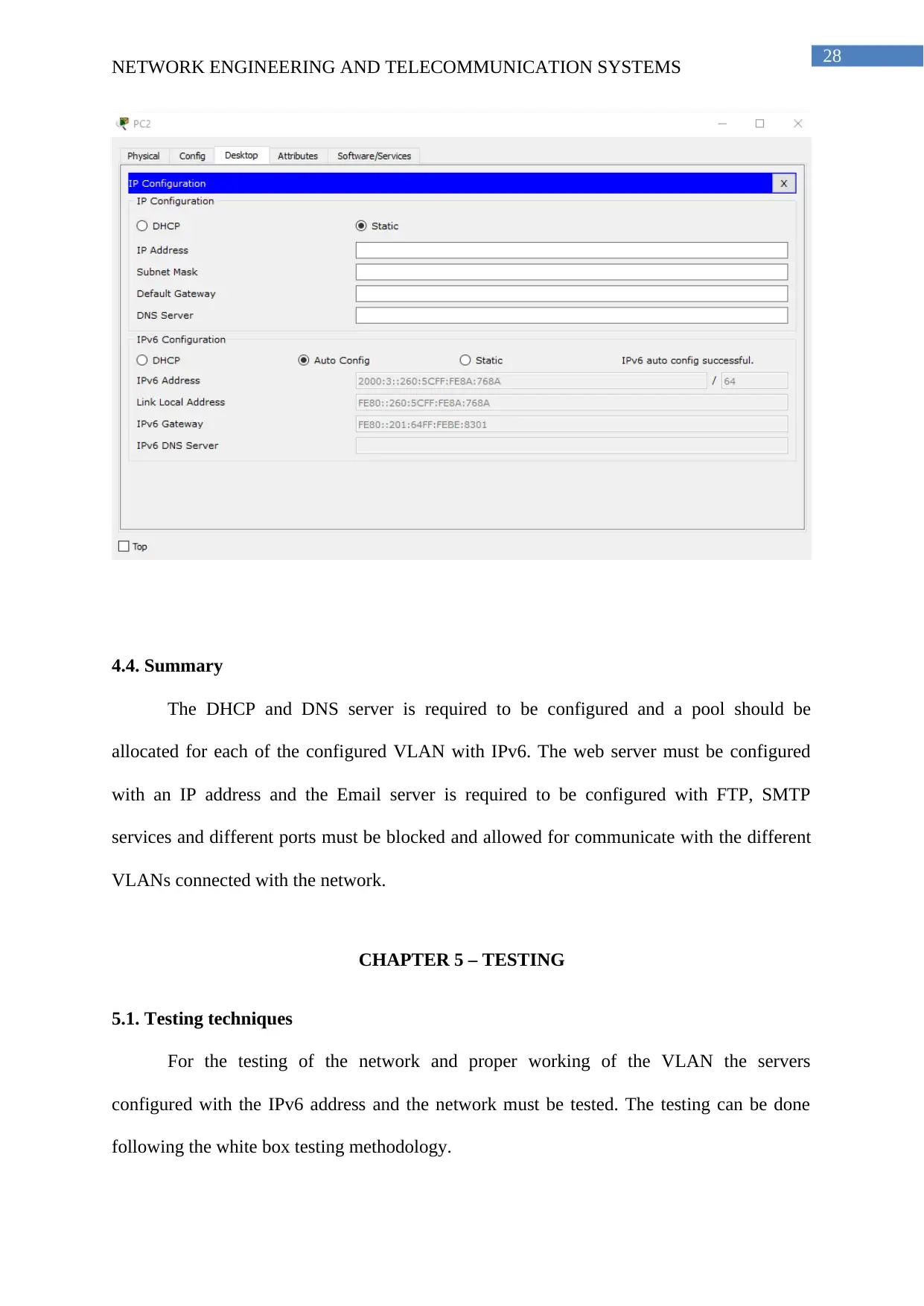
28
NETWORK ENGINEERING AND TELECOMMUNICATION SYSTEMS
4.4. Summary
The DHCP and DNS server is required to be configured and a pool should be
allocated for each of the configured VLAN with IPv6. The web server must be configured
with an IP address and the Email server is required to be configured with FTP, SMTP
services and different ports must be blocked and allowed for communicate with the different
VLANs connected with the network.
CHAPTER 5 – TESTING
5.1. Testing techniques
For the testing of the network and proper working of the VLAN the servers
configured with the IPv6 address and the network must be tested. The testing can be done
following the white box testing methodology.
NETWORK ENGINEERING AND TELECOMMUNICATION SYSTEMS
4.4. Summary
The DHCP and DNS server is required to be configured and a pool should be
allocated for each of the configured VLAN with IPv6. The web server must be configured
with an IP address and the Email server is required to be configured with FTP, SMTP
services and different ports must be blocked and allowed for communicate with the different
VLANs connected with the network.
CHAPTER 5 – TESTING
5.1. Testing techniques
For the testing of the network and proper working of the VLAN the servers
configured with the IPv6 address and the network must be tested. The testing can be done
following the white box testing methodology.
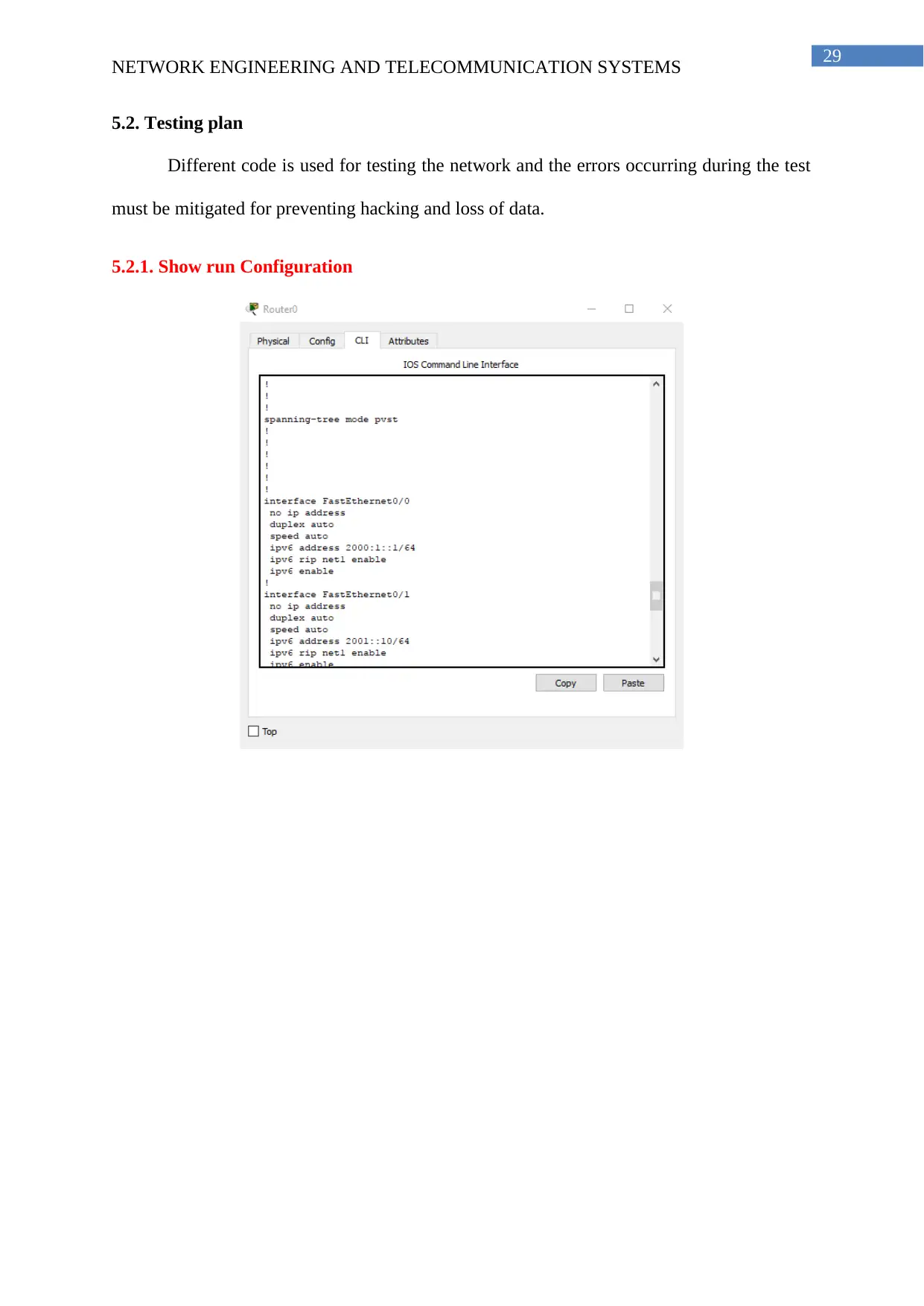
29
NETWORK ENGINEERING AND TELECOMMUNICATION SYSTEMS
5.2. Testing plan
Different code is used for testing the network and the errors occurring during the test
must be mitigated for preventing hacking and loss of data.
5.2.1. Show run Configuration
NETWORK ENGINEERING AND TELECOMMUNICATION SYSTEMS
5.2. Testing plan
Different code is used for testing the network and the errors occurring during the test
must be mitigated for preventing hacking and loss of data.
5.2.1. Show run Configuration
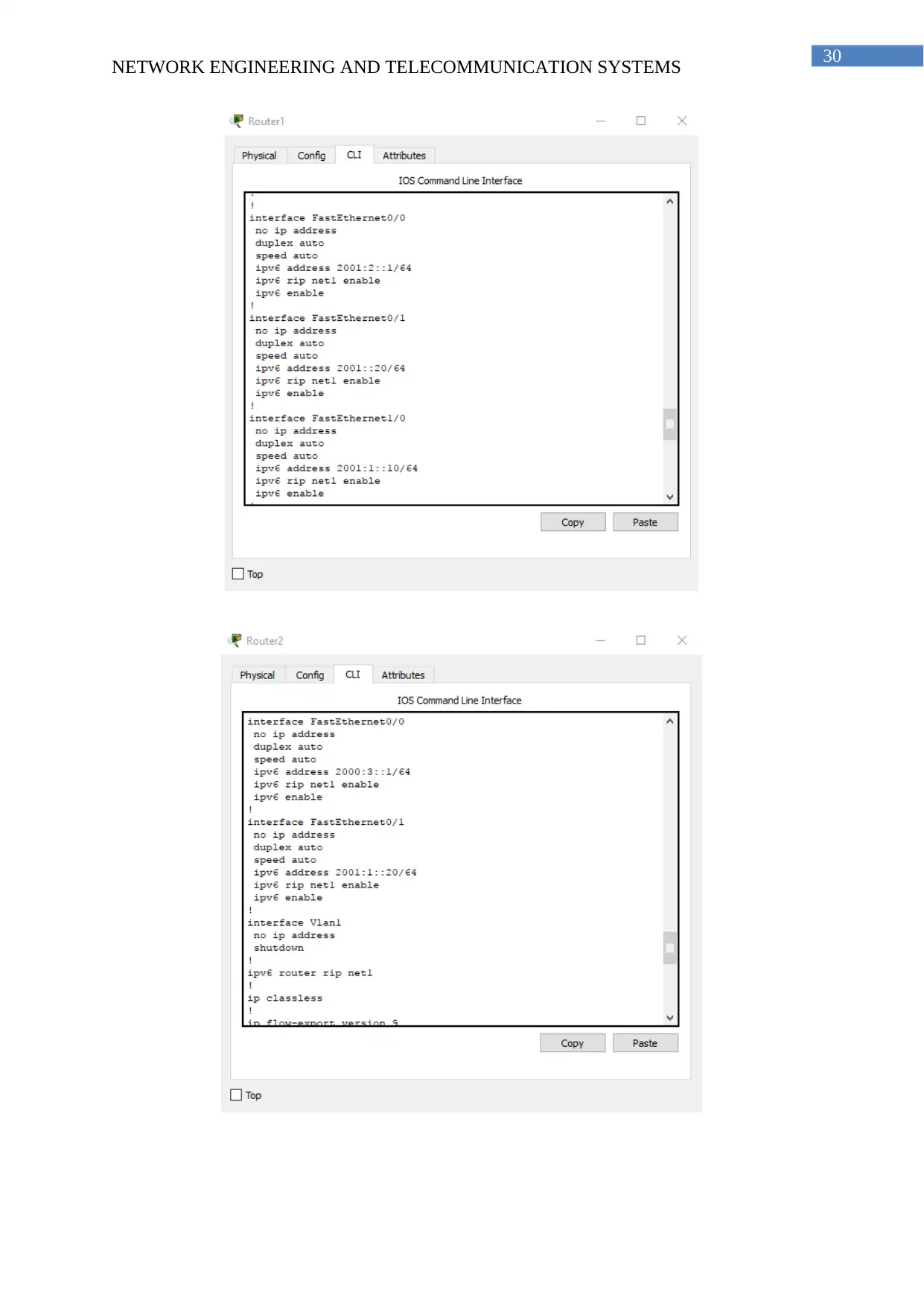
30
NETWORK ENGINEERING AND TELECOMMUNICATION SYSTEMS
NETWORK ENGINEERING AND TELECOMMUNICATION SYSTEMS
Paraphrase This Document
Need a fresh take? Get an instant paraphrase of this document with our AI Paraphraser
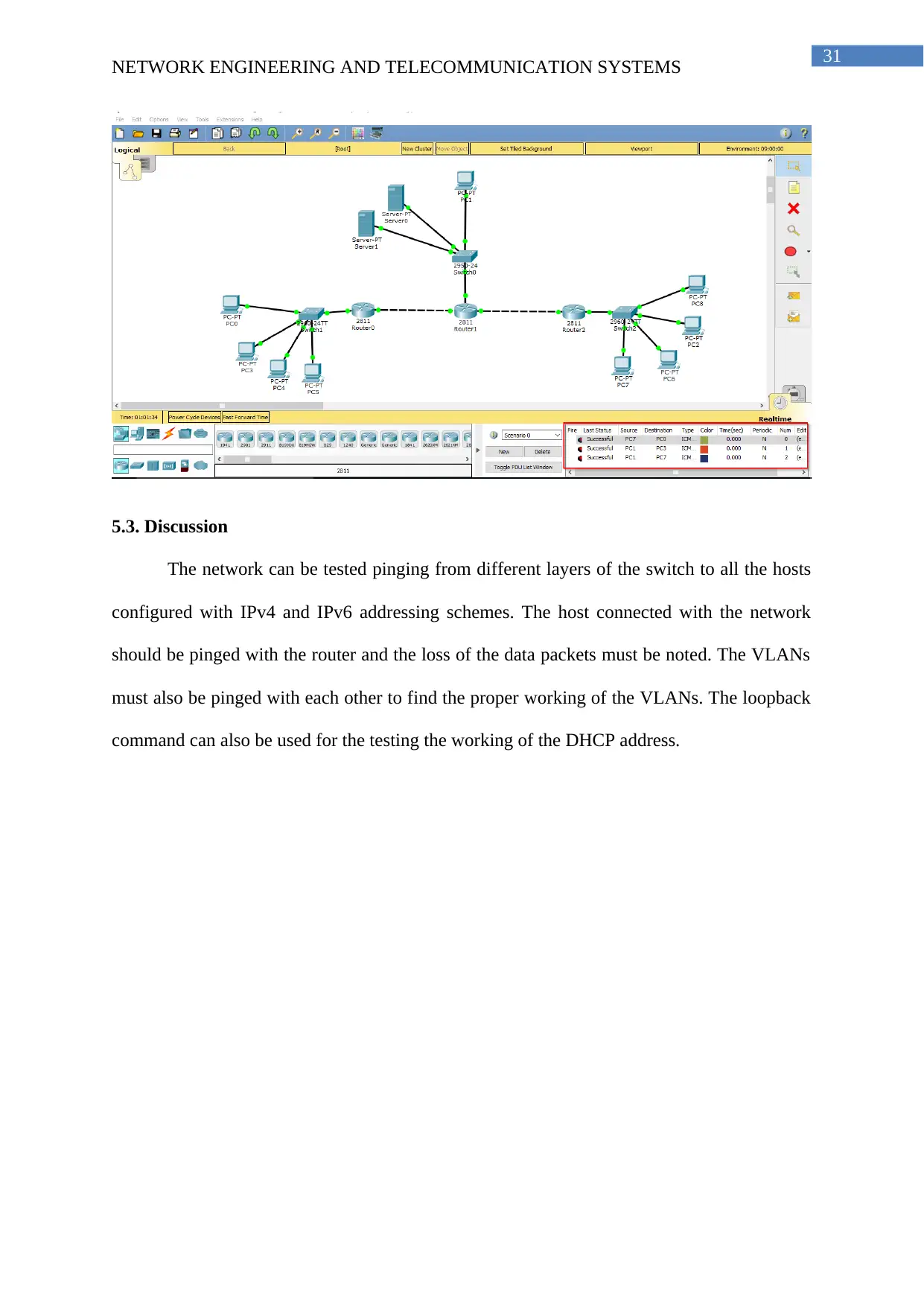
31
NETWORK ENGINEERING AND TELECOMMUNICATION SYSTEMS
5.3. Discussion
The network can be tested pinging from different layers of the switch to all the hosts
configured with IPv4 and IPv6 addressing schemes. The host connected with the network
should be pinged with the router and the loss of the data packets must be noted. The VLANs
must also be pinged with each other to find the proper working of the VLANs. The loopback
command can also be used for the testing the working of the DHCP address.
NETWORK ENGINEERING AND TELECOMMUNICATION SYSTEMS
5.3. Discussion
The network can be tested pinging from different layers of the switch to all the hosts
configured with IPv4 and IPv6 addressing schemes. The host connected with the network
should be pinged with the router and the loss of the data packets must be noted. The VLANs
must also be pinged with each other to find the proper working of the VLANs. The loopback
command can also be used for the testing the working of the DHCP address.
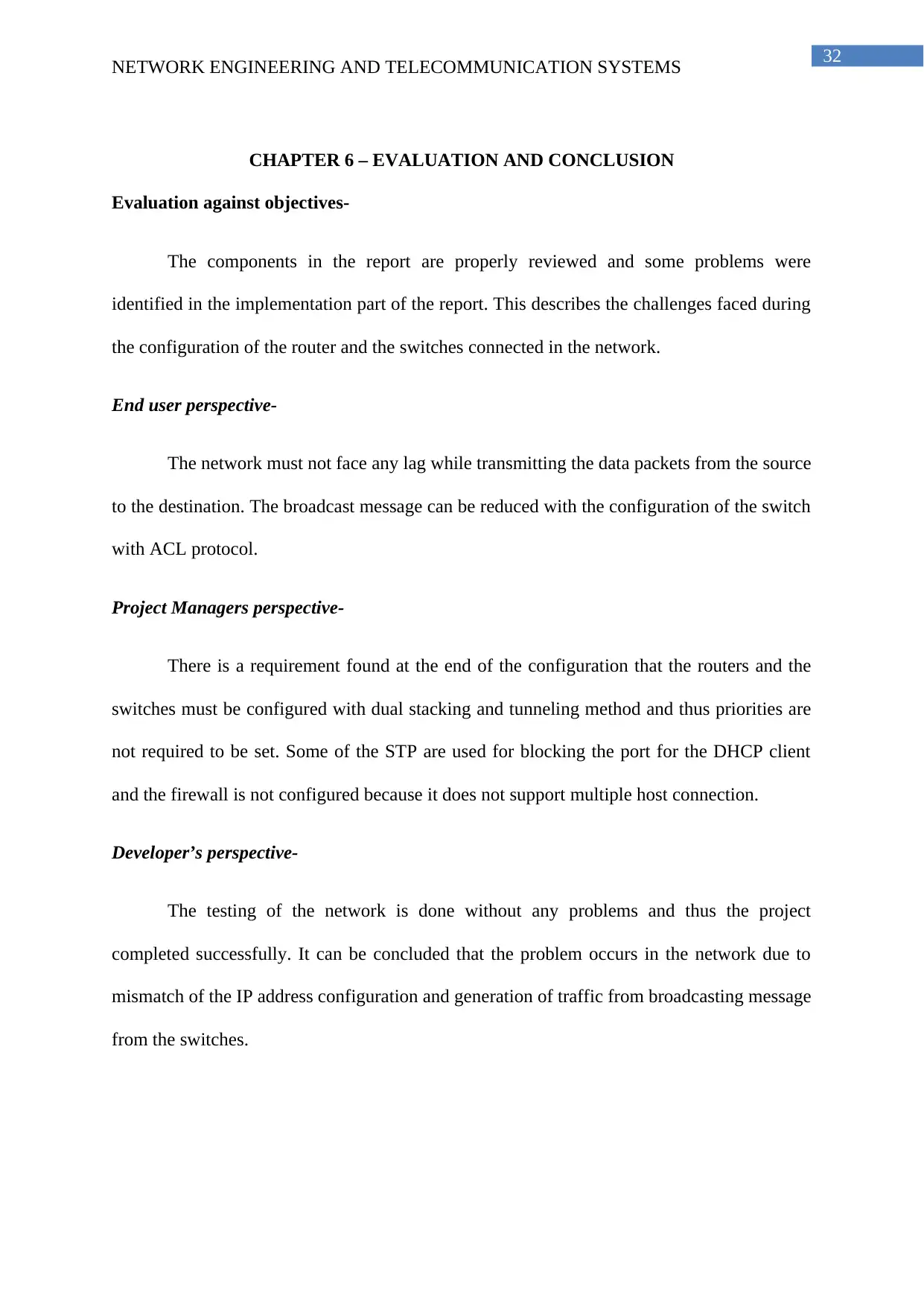
32
NETWORK ENGINEERING AND TELECOMMUNICATION SYSTEMS
CHAPTER 6 – EVALUATION AND CONCLUSION
Evaluation against objectives-
The components in the report are properly reviewed and some problems were
identified in the implementation part of the report. This describes the challenges faced during
the configuration of the router and the switches connected in the network.
End user perspective-
The network must not face any lag while transmitting the data packets from the source
to the destination. The broadcast message can be reduced with the configuration of the switch
with ACL protocol.
Project Managers perspective-
There is a requirement found at the end of the configuration that the routers and the
switches must be configured with dual stacking and tunneling method and thus priorities are
not required to be set. Some of the STP are used for blocking the port for the DHCP client
and the firewall is not configured because it does not support multiple host connection.
Developer’s perspective-
The testing of the network is done without any problems and thus the project
completed successfully. It can be concluded that the problem occurs in the network due to
mismatch of the IP address configuration and generation of traffic from broadcasting message
from the switches.
NETWORK ENGINEERING AND TELECOMMUNICATION SYSTEMS
CHAPTER 6 – EVALUATION AND CONCLUSION
Evaluation against objectives-
The components in the report are properly reviewed and some problems were
identified in the implementation part of the report. This describes the challenges faced during
the configuration of the router and the switches connected in the network.
End user perspective-
The network must not face any lag while transmitting the data packets from the source
to the destination. The broadcast message can be reduced with the configuration of the switch
with ACL protocol.
Project Managers perspective-
There is a requirement found at the end of the configuration that the routers and the
switches must be configured with dual stacking and tunneling method and thus priorities are
not required to be set. Some of the STP are used for blocking the port for the DHCP client
and the firewall is not configured because it does not support multiple host connection.
Developer’s perspective-
The testing of the network is done without any problems and thus the project
completed successfully. It can be concluded that the problem occurs in the network due to
mismatch of the IP address configuration and generation of traffic from broadcasting message
from the switches.

33
NETWORK ENGINEERING AND TELECOMMUNICATION SYSTEMS
OVERALL CONCLUSION SUMMARY
The report is prepared analyzing the different methodology and configuration
techniques used for configuring an Internet protocol address. The project is developed after a
proper planning and preparation of a gnat chart. A literature review of the project is prepared
for understanding the working principle of Internet protocol. Then the analysis and the design
of the network are done. After the preparation of the design the solution is required to be
tested multiple time for finding errors in the system and mitigate it immediately. The whole
project has been developed on Cisco Packet Tracer and minor complication was faced for
running the commands and different resources were studied for configuring the router and the
switches with IPv6 protocol.
Future development
The configured network with IPv6 has eliminated the risk of data loss in the current
network from the study on the networking concept it has been found that the configuration of
the router with ACL command can be used for removing the bottleneck. Thus there is scope
of future development of the project. I have a keen interest on the network and security the
security in the proposed network can be improved with configuring the firewall and allowing
and blocking request from different terminals. The intrusion attack on the network is required
to be eliminated for increasing the efficiency of the network. Different authentication
methods are required to be applied in the hardware devices for the proper working of the
system.
NETWORK ENGINEERING AND TELECOMMUNICATION SYSTEMS
OVERALL CONCLUSION SUMMARY
The report is prepared analyzing the different methodology and configuration
techniques used for configuring an Internet protocol address. The project is developed after a
proper planning and preparation of a gnat chart. A literature review of the project is prepared
for understanding the working principle of Internet protocol. Then the analysis and the design
of the network are done. After the preparation of the design the solution is required to be
tested multiple time for finding errors in the system and mitigate it immediately. The whole
project has been developed on Cisco Packet Tracer and minor complication was faced for
running the commands and different resources were studied for configuring the router and the
switches with IPv6 protocol.
Future development
The configured network with IPv6 has eliminated the risk of data loss in the current
network from the study on the networking concept it has been found that the configuration of
the router with ACL command can be used for removing the bottleneck. Thus there is scope
of future development of the project. I have a keen interest on the network and security the
security in the proposed network can be improved with configuring the firewall and allowing
and blocking request from different terminals. The intrusion attack on the network is required
to be eliminated for increasing the efficiency of the network. Different authentication
methods are required to be applied in the hardware devices for the proper working of the
system.
Secure Best Marks with AI Grader
Need help grading? Try our AI Grader for instant feedback on your assignments.
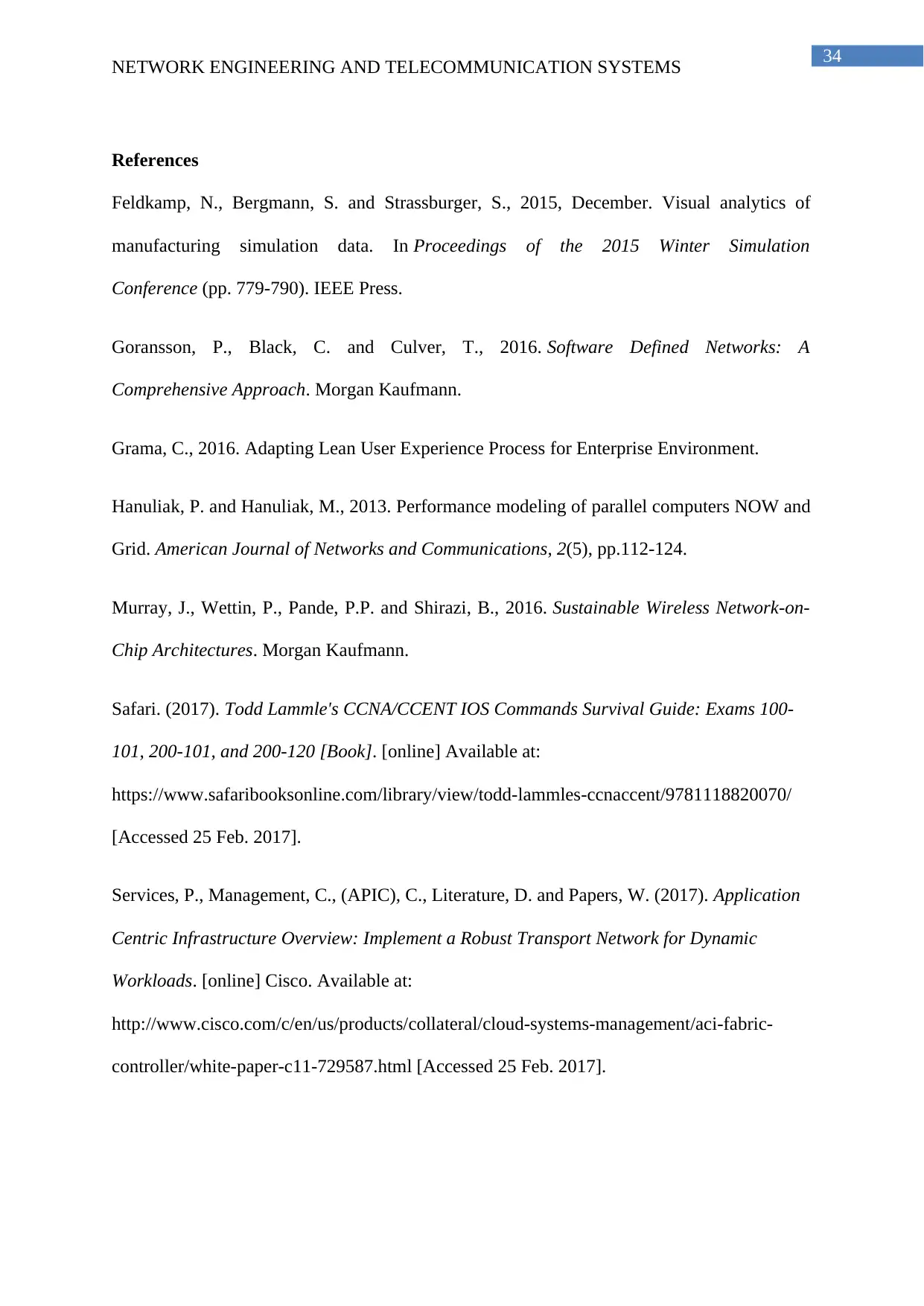
34
NETWORK ENGINEERING AND TELECOMMUNICATION SYSTEMS
References
Feldkamp, N., Bergmann, S. and Strassburger, S., 2015, December. Visual analytics of
manufacturing simulation data. In Proceedings of the 2015 Winter Simulation
Conference (pp. 779-790). IEEE Press.
Goransson, P., Black, C. and Culver, T., 2016. Software Defined Networks: A
Comprehensive Approach. Morgan Kaufmann.
Grama, C., 2016. Adapting Lean User Experience Process for Enterprise Environment.
Hanuliak, P. and Hanuliak, M., 2013. Performance modeling of parallel computers NOW and
Grid. American Journal of Networks and Communications, 2(5), pp.112-124.
Murray, J., Wettin, P., Pande, P.P. and Shirazi, B., 2016. Sustainable Wireless Network-on-
Chip Architectures. Morgan Kaufmann.
Safari. (2017). Todd Lammle's CCNA/CCENT IOS Commands Survival Guide: Exams 100-
101, 200-101, and 200-120 [Book]. [online] Available at:
https://www.safaribooksonline.com/library/view/todd-lammles-ccnaccent/9781118820070/
[Accessed 25 Feb. 2017].
Services, P., Management, C., (APIC), C., Literature, D. and Papers, W. (2017). Application
Centric Infrastructure Overview: Implement a Robust Transport Network for Dynamic
Workloads. [online] Cisco. Available at:
http://www.cisco.com/c/en/us/products/collateral/cloud-systems-management/aci-fabric-
controller/white-paper-c11-729587.html [Accessed 25 Feb. 2017].
NETWORK ENGINEERING AND TELECOMMUNICATION SYSTEMS
References
Feldkamp, N., Bergmann, S. and Strassburger, S., 2015, December. Visual analytics of
manufacturing simulation data. In Proceedings of the 2015 Winter Simulation
Conference (pp. 779-790). IEEE Press.
Goransson, P., Black, C. and Culver, T., 2016. Software Defined Networks: A
Comprehensive Approach. Morgan Kaufmann.
Grama, C., 2016. Adapting Lean User Experience Process for Enterprise Environment.
Hanuliak, P. and Hanuliak, M., 2013. Performance modeling of parallel computers NOW and
Grid. American Journal of Networks and Communications, 2(5), pp.112-124.
Murray, J., Wettin, P., Pande, P.P. and Shirazi, B., 2016. Sustainable Wireless Network-on-
Chip Architectures. Morgan Kaufmann.
Safari. (2017). Todd Lammle's CCNA/CCENT IOS Commands Survival Guide: Exams 100-
101, 200-101, and 200-120 [Book]. [online] Available at:
https://www.safaribooksonline.com/library/view/todd-lammles-ccnaccent/9781118820070/
[Accessed 25 Feb. 2017].
Services, P., Management, C., (APIC), C., Literature, D. and Papers, W. (2017). Application
Centric Infrastructure Overview: Implement a Robust Transport Network for Dynamic
Workloads. [online] Cisco. Available at:
http://www.cisco.com/c/en/us/products/collateral/cloud-systems-management/aci-fabric-
controller/white-paper-c11-729587.html [Accessed 25 Feb. 2017].
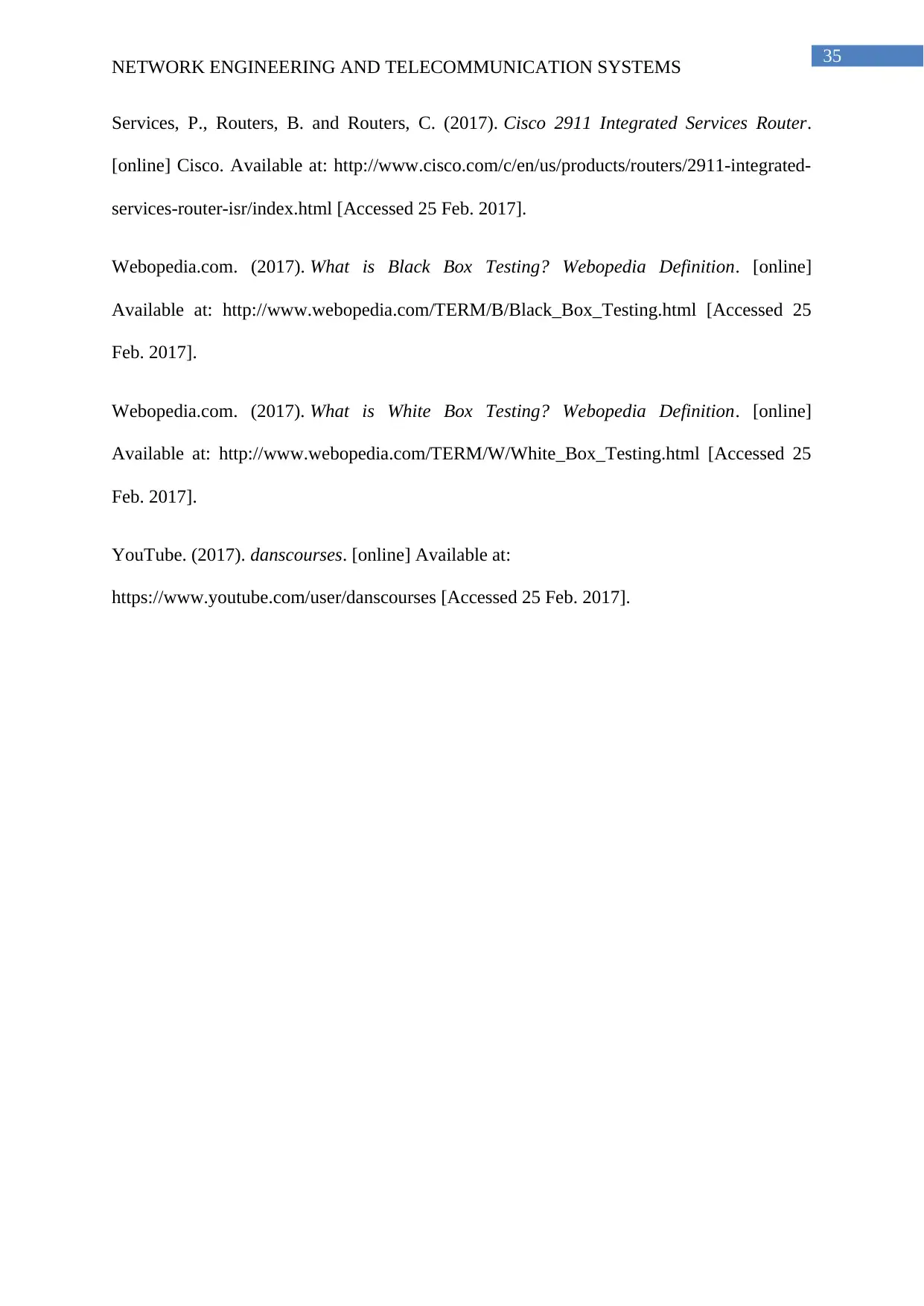
35
NETWORK ENGINEERING AND TELECOMMUNICATION SYSTEMS
Services, P., Routers, B. and Routers, C. (2017). Cisco 2911 Integrated Services Router.
[online] Cisco. Available at: http://www.cisco.com/c/en/us/products/routers/2911-integrated-
services-router-isr/index.html [Accessed 25 Feb. 2017].
Webopedia.com. (2017). What is Black Box Testing? Webopedia Definition. [online]
Available at: http://www.webopedia.com/TERM/B/Black_Box_Testing.html [Accessed 25
Feb. 2017].
Webopedia.com. (2017). What is White Box Testing? Webopedia Definition. [online]
Available at: http://www.webopedia.com/TERM/W/White_Box_Testing.html [Accessed 25
Feb. 2017].
YouTube. (2017). danscourses. [online] Available at:
https://www.youtube.com/user/danscourses [Accessed 25 Feb. 2017].
NETWORK ENGINEERING AND TELECOMMUNICATION SYSTEMS
Services, P., Routers, B. and Routers, C. (2017). Cisco 2911 Integrated Services Router.
[online] Cisco. Available at: http://www.cisco.com/c/en/us/products/routers/2911-integrated-
services-router-isr/index.html [Accessed 25 Feb. 2017].
Webopedia.com. (2017). What is Black Box Testing? Webopedia Definition. [online]
Available at: http://www.webopedia.com/TERM/B/Black_Box_Testing.html [Accessed 25
Feb. 2017].
Webopedia.com. (2017). What is White Box Testing? Webopedia Definition. [online]
Available at: http://www.webopedia.com/TERM/W/White_Box_Testing.html [Accessed 25
Feb. 2017].
YouTube. (2017). danscourses. [online] Available at:
https://www.youtube.com/user/danscourses [Accessed 25 Feb. 2017].

36
NETWORK ENGINEERING AND TELECOMMUNICATION SYSTEMS
Appendix - A
HND PROJECT PRESENTATION
NETWORK ENGINEERING AND TELECOMMUNICATION SYSTEMS
Appendix - A
HND PROJECT PRESENTATION
Paraphrase This Document
Need a fresh take? Get an instant paraphrase of this document with our AI Paraphraser
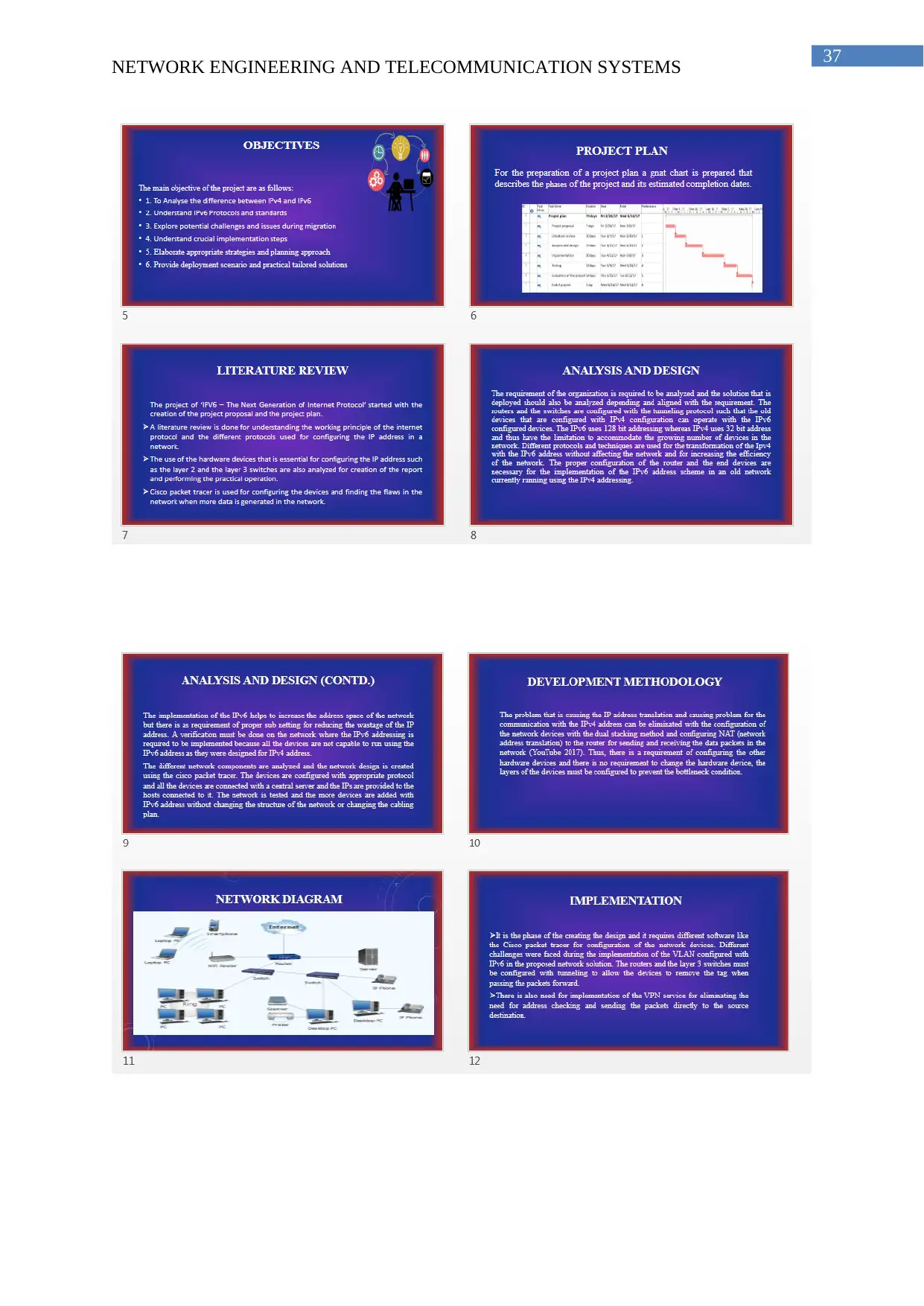
37
NETWORK ENGINEERING AND TELECOMMUNICATION SYSTEMS
NETWORK ENGINEERING AND TELECOMMUNICATION SYSTEMS

38
NETWORK ENGINEERING AND TELECOMMUNICATION SYSTEMS
NETWORK ENGINEERING AND TELECOMMUNICATION SYSTEMS

39
NETWORK ENGINEERING AND TELECOMMUNICATION SYSTEMS
Appendix – B
PROJECT SPECIFICATION DOCUMENT
Student Name: Student ID:
Project Title: IPV6 – The Next Generation of Internet Protocol
Pathway:
AIM: The main aim of the project is to analyze the internet protocol suite and its
foundation protocol IP versions and highlight the emergence of the IPv6 with the growth of
the internet. The issues associated with the deployment of the IPv6 is also analyzed and
documented in the report.
Objectives:
The main objective of the project are as follows:
1. To analyze the growth of the internet and the needs for the deployment of the IPv6
address
2. To create a gnat chart describing the project plan for the development of the project
3. To realize the aim of the project and proceed with the project plan for further
development of the project
NETWORK ENGINEERING AND TELECOMMUNICATION SYSTEMS
Appendix – B
PROJECT SPECIFICATION DOCUMENT
Student Name: Student ID:
Project Title: IPV6 – The Next Generation of Internet Protocol
Pathway:
AIM: The main aim of the project is to analyze the internet protocol suite and its
foundation protocol IP versions and highlight the emergence of the IPv6 with the growth of
the internet. The issues associated with the deployment of the IPv6 is also analyzed and
documented in the report.
Objectives:
The main objective of the project are as follows:
1. To analyze the growth of the internet and the needs for the deployment of the IPv6
address
2. To create a gnat chart describing the project plan for the development of the project
3. To realize the aim of the project and proceed with the project plan for further
development of the project
Secure Best Marks with AI Grader
Need help grading? Try our AI Grader for instant feedback on your assignments.

40
NETWORK ENGINEERING AND TELECOMMUNICATION SYSTEMS
4. To analyze the scope of the project and the where it can be applied for increasing the
operatibility of the network
Brief Description:
The project of ‘IPV6 – The Next Generation of Internet Protocol’ started with the creation
of the project proposal and the project plan. A literature review is done for understanding
the working principle of the internet protocol and the different protocols used for
configuring the IP address in a network. The use of the hardware devices that is essential
for configuring the IP address such as the layer 2 and the layer 3 switches are also analyzed
for creation of the report and performing the practical operation. Cisco packet tracer is used
for configuring the devices and finding the flaws in the network when more data is
generated in the network. The routers and the switches are configured with the tunneling
protocol such that the old devices that are configured with IPv4 configuration can operate
with the IPv6 configured devices. The IPv6 uses 128 bit addressing whereas IPv4 uses 32
bit address and thus have the limitation to accommodate the growing number of devices in
the network. Different protocols and techniques are used for the transformation of the Ipv4
with the IPv6 address without affecting the network and for increasing the efficiency of the
network. The proper configuration of the router and the end devices are necessary for the
implementation of the IPv6 address scheme in an old network currently running using the
IPv4 addressing. The implementation of the IPv6 helps to increase the address space of the
network but there is as requirement of proper subnetting for reducing the wastage of the IP
address. A verification must be done on the network where the IPv6 addressing is required
to be implemented because all the devices are not capable to run using the IPv6 address as
NETWORK ENGINEERING AND TELECOMMUNICATION SYSTEMS
4. To analyze the scope of the project and the where it can be applied for increasing the
operatibility of the network
Brief Description:
The project of ‘IPV6 – The Next Generation of Internet Protocol’ started with the creation
of the project proposal and the project plan. A literature review is done for understanding
the working principle of the internet protocol and the different protocols used for
configuring the IP address in a network. The use of the hardware devices that is essential
for configuring the IP address such as the layer 2 and the layer 3 switches are also analyzed
for creation of the report and performing the practical operation. Cisco packet tracer is used
for configuring the devices and finding the flaws in the network when more data is
generated in the network. The routers and the switches are configured with the tunneling
protocol such that the old devices that are configured with IPv4 configuration can operate
with the IPv6 configured devices. The IPv6 uses 128 bit addressing whereas IPv4 uses 32
bit address and thus have the limitation to accommodate the growing number of devices in
the network. Different protocols and techniques are used for the transformation of the Ipv4
with the IPv6 address without affecting the network and for increasing the efficiency of the
network. The proper configuration of the router and the end devices are necessary for the
implementation of the IPv6 address scheme in an old network currently running using the
IPv4 addressing. The implementation of the IPv6 helps to increase the address space of the
network but there is as requirement of proper subnetting for reducing the wastage of the IP
address. A verification must be done on the network where the IPv6 addressing is required
to be implemented because all the devices are not capable to run using the IPv6 address as

41
NETWORK ENGINEERING AND TELECOMMUNICATION SYSTEMS
they were designed for IPv4 address.
The objectives of the project are aligned during the development of the project. The
different network components are analyzed and the network design is created using the
cisco packet tracer. The devices are configured with appropriate protocol and all the
devices are connected with a central server and the IPs are provided to the hosts connected
to it. The network is tested and the more devices are added with IPv6 address without
changing the structure of the network or changing the cabling plan. A power point poster
and slides are created for the demonstration of the proper working of the project.
Special Conditions; eg assumptions, risks
It is assumed that only cisco network devices are used for designing the network. This is
because we are using the cisco packet tracer software and here there is no other device
available. Thus only cisco routers and switches are used for designing and analysis.
Limited numbers of hosts are used for the configuration and they are grouped into two
parts. The first groups of hosts are configured with IPv4 address while the second group is
configured with IPv6 address. The network is created in the cisco layer 3 switch and it is
also assumed that during the implementation phase the cisco devices would have the same
ports and configuration as the other devices available in the market.
There are different risks that may arise during the development of the project such as lack
of expertise for proper configuration of the project. The device chosen for deigning the
network may not have the proper function required for configuration of the device. The
time also acts as a factor because the project is required to be completed with a time of six
NETWORK ENGINEERING AND TELECOMMUNICATION SYSTEMS
they were designed for IPv4 address.
The objectives of the project are aligned during the development of the project. The
different network components are analyzed and the network design is created using the
cisco packet tracer. The devices are configured with appropriate protocol and all the
devices are connected with a central server and the IPs are provided to the hosts connected
to it. The network is tested and the more devices are added with IPv6 address without
changing the structure of the network or changing the cabling plan. A power point poster
and slides are created for the demonstration of the proper working of the project.
Special Conditions; eg assumptions, risks
It is assumed that only cisco network devices are used for designing the network. This is
because we are using the cisco packet tracer software and here there is no other device
available. Thus only cisco routers and switches are used for designing and analysis.
Limited numbers of hosts are used for the configuration and they are grouped into two
parts. The first groups of hosts are configured with IPv4 address while the second group is
configured with IPv6 address. The network is created in the cisco layer 3 switch and it is
also assumed that during the implementation phase the cisco devices would have the same
ports and configuration as the other devices available in the market.
There are different risks that may arise during the development of the project such as lack
of expertise for proper configuration of the project. The device chosen for deigning the
network may not have the proper function required for configuration of the device. The
time also acts as a factor because the project is required to be completed with a time of six
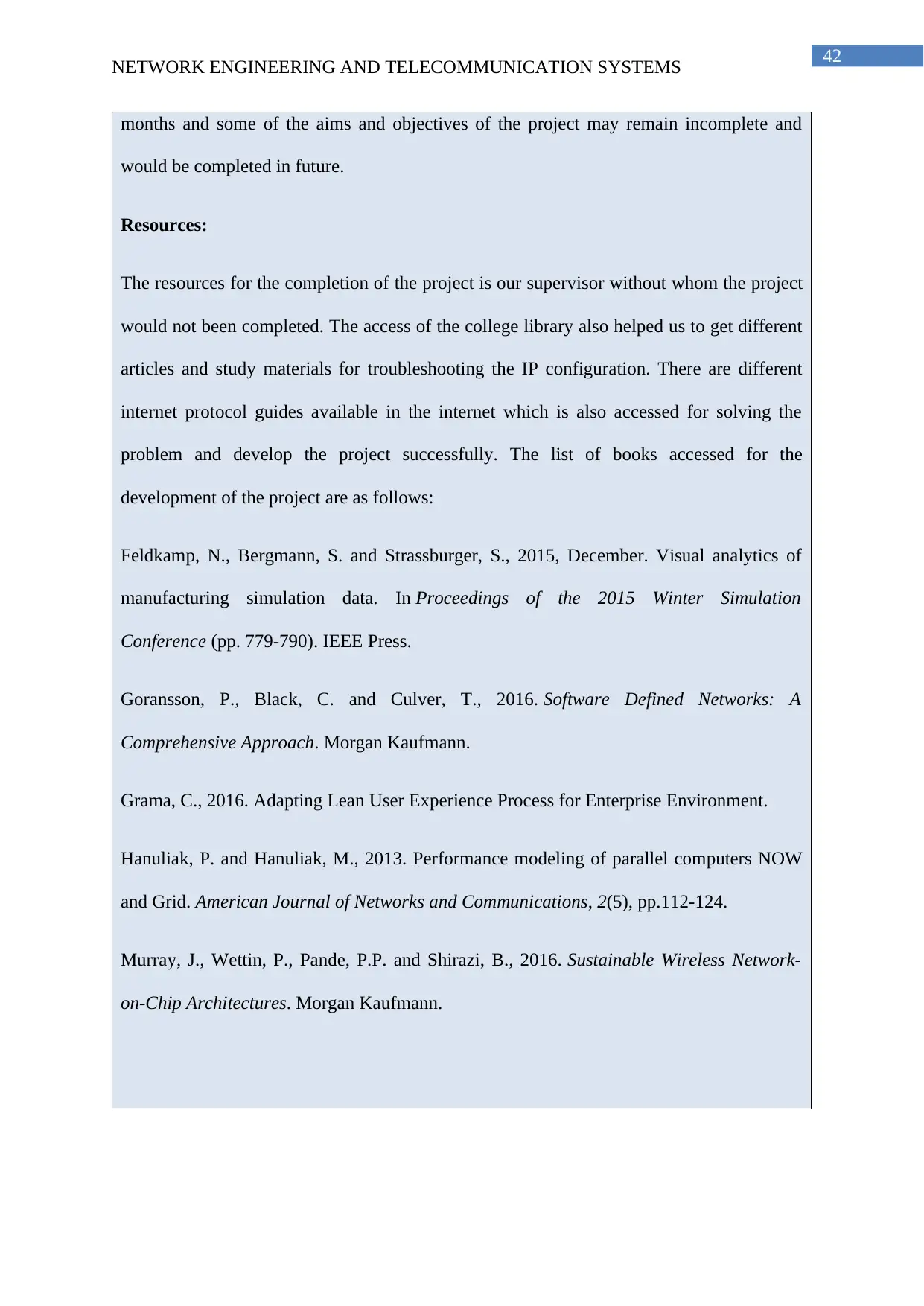
42
NETWORK ENGINEERING AND TELECOMMUNICATION SYSTEMS
months and some of the aims and objectives of the project may remain incomplete and
would be completed in future.
Resources:
The resources for the completion of the project is our supervisor without whom the project
would not been completed. The access of the college library also helped us to get different
articles and study materials for troubleshooting the IP configuration. There are different
internet protocol guides available in the internet which is also accessed for solving the
problem and develop the project successfully. The list of books accessed for the
development of the project are as follows:
Feldkamp, N., Bergmann, S. and Strassburger, S., 2015, December. Visual analytics of
manufacturing simulation data. In Proceedings of the 2015 Winter Simulation
Conference (pp. 779-790). IEEE Press.
Goransson, P., Black, C. and Culver, T., 2016. Software Defined Networks: A
Comprehensive Approach. Morgan Kaufmann.
Grama, C., 2016. Adapting Lean User Experience Process for Enterprise Environment.
Hanuliak, P. and Hanuliak, M., 2013. Performance modeling of parallel computers NOW
and Grid. American Journal of Networks and Communications, 2(5), pp.112-124.
Murray, J., Wettin, P., Pande, P.P. and Shirazi, B., 2016. Sustainable Wireless Network-
on-Chip Architectures. Morgan Kaufmann.
NETWORK ENGINEERING AND TELECOMMUNICATION SYSTEMS
months and some of the aims and objectives of the project may remain incomplete and
would be completed in future.
Resources:
The resources for the completion of the project is our supervisor without whom the project
would not been completed. The access of the college library also helped us to get different
articles and study materials for troubleshooting the IP configuration. There are different
internet protocol guides available in the internet which is also accessed for solving the
problem and develop the project successfully. The list of books accessed for the
development of the project are as follows:
Feldkamp, N., Bergmann, S. and Strassburger, S., 2015, December. Visual analytics of
manufacturing simulation data. In Proceedings of the 2015 Winter Simulation
Conference (pp. 779-790). IEEE Press.
Goransson, P., Black, C. and Culver, T., 2016. Software Defined Networks: A
Comprehensive Approach. Morgan Kaufmann.
Grama, C., 2016. Adapting Lean User Experience Process for Enterprise Environment.
Hanuliak, P. and Hanuliak, M., 2013. Performance modeling of parallel computers NOW
and Grid. American Journal of Networks and Communications, 2(5), pp.112-124.
Murray, J., Wettin, P., Pande, P.P. and Shirazi, B., 2016. Sustainable Wireless Network-
on-Chip Architectures. Morgan Kaufmann.
Paraphrase This Document
Need a fresh take? Get an instant paraphrase of this document with our AI Paraphraser

43
NETWORK ENGINEERING AND TELECOMMUNICATION SYSTEMS
Comments:
SIGNED OFF: STUDENT:
DATE:
Project Supervisor
NETWORK ENGINEERING AND TELECOMMUNICATION SYSTEMS
Comments:
SIGNED OFF: STUDENT:
DATE:
Project Supervisor
1 out of 44
Related Documents
Your All-in-One AI-Powered Toolkit for Academic Success.
+13062052269
info@desklib.com
Available 24*7 on WhatsApp / Email
![[object Object]](/_next/static/media/star-bottom.7253800d.svg)
Unlock your academic potential
© 2024 | Zucol Services PVT LTD | All rights reserved.





